Minimalist living rooms have evolved far beyond stark white spaces to embrace warmth, functionality, and personal style in 2025. Today's minimalist approach focuses on intentional design choices that maximize both comfort and visual appeal while maintaining the essential "less is more" philosophy. From incorporating natural materials and sustainable elements to creating layered lighting schemes and smart storage solutions, modern minimalist living rooms prove that simplicity doesn't mean sacrificing character. Whether you're drawn to warm neutral palettes, organic shapes, or innovative furniture arrangements, these design ideas demonstrate how minimalist principles can create serene, clutter-free spaces that feel both contemporary and timeless. Each concept represents a complete design theme that transforms your living room into a peaceful retreat.
1. Scandinavian-Inspired Minimalist Living Room with Natural Wood Elements
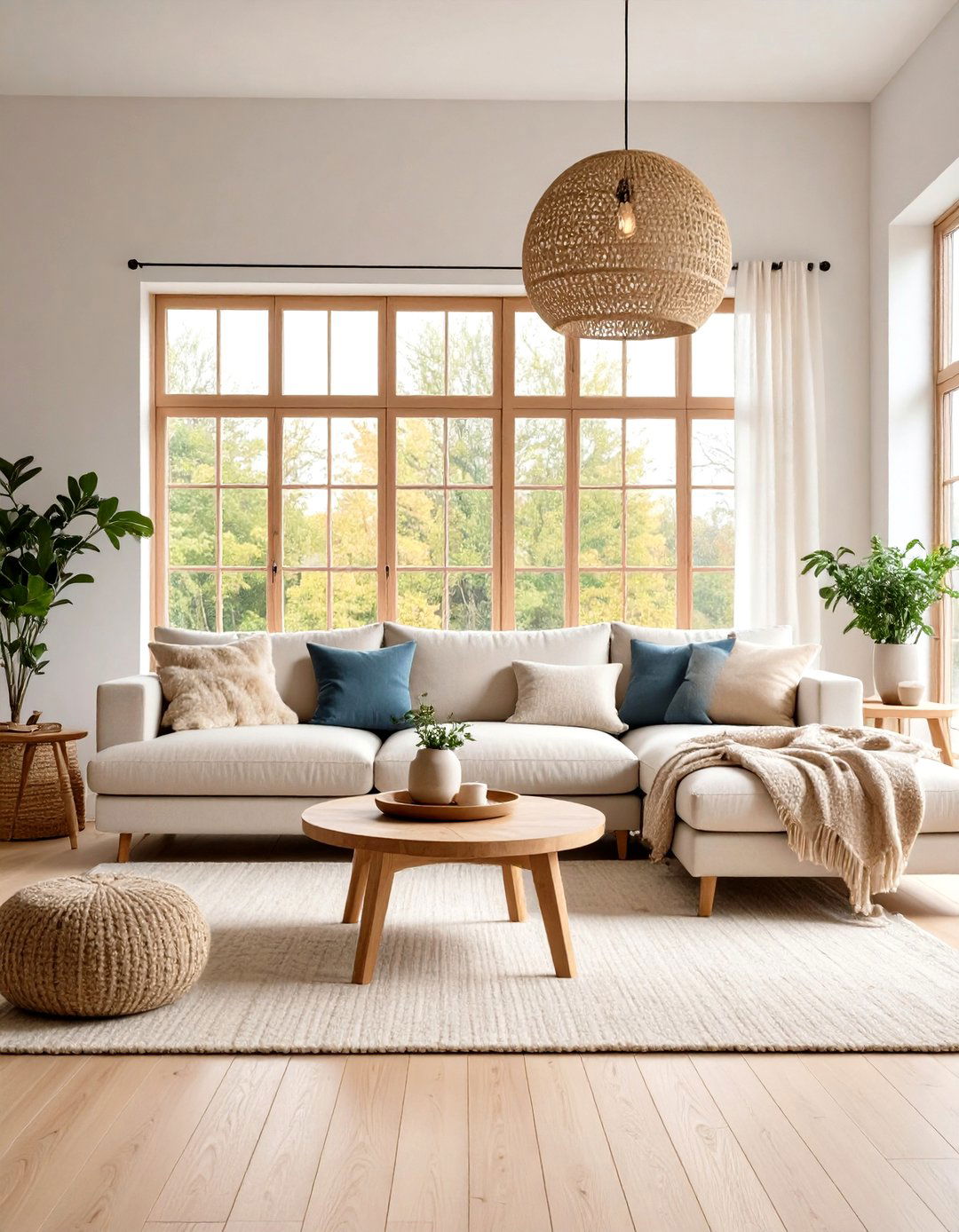
Creating a Scandinavian-inspired minimalist living room centers around the perfect balance of light woods, neutral textiles, and functional furniture. This design theme emphasizes pale timber flooring paired with a low-profile sectional sofa in soft linen or cotton fabrics. The color palette remains consistently warm with whites, creams, and gentle beiges throughout the space. Natural wood coffee tables and floating shelves add organic warmth while maintaining clean lines essential to minimalist design. Large windows maximize natural light, complemented by simple pendant lighting with wooden or ceramic elements. Textural interest comes from woven throws, sheepskin rugs, and ceramic vases that celebrate Scandinavian craftsmanship. The overall atmosphere promotes hygge-inspired comfort while keeping surfaces clear and purposeful, proving that minimalist living rooms can feel both serene and welcoming without unnecessary ornamentation.
2. Monochromatic Minimalist Living Room in Warm Grays
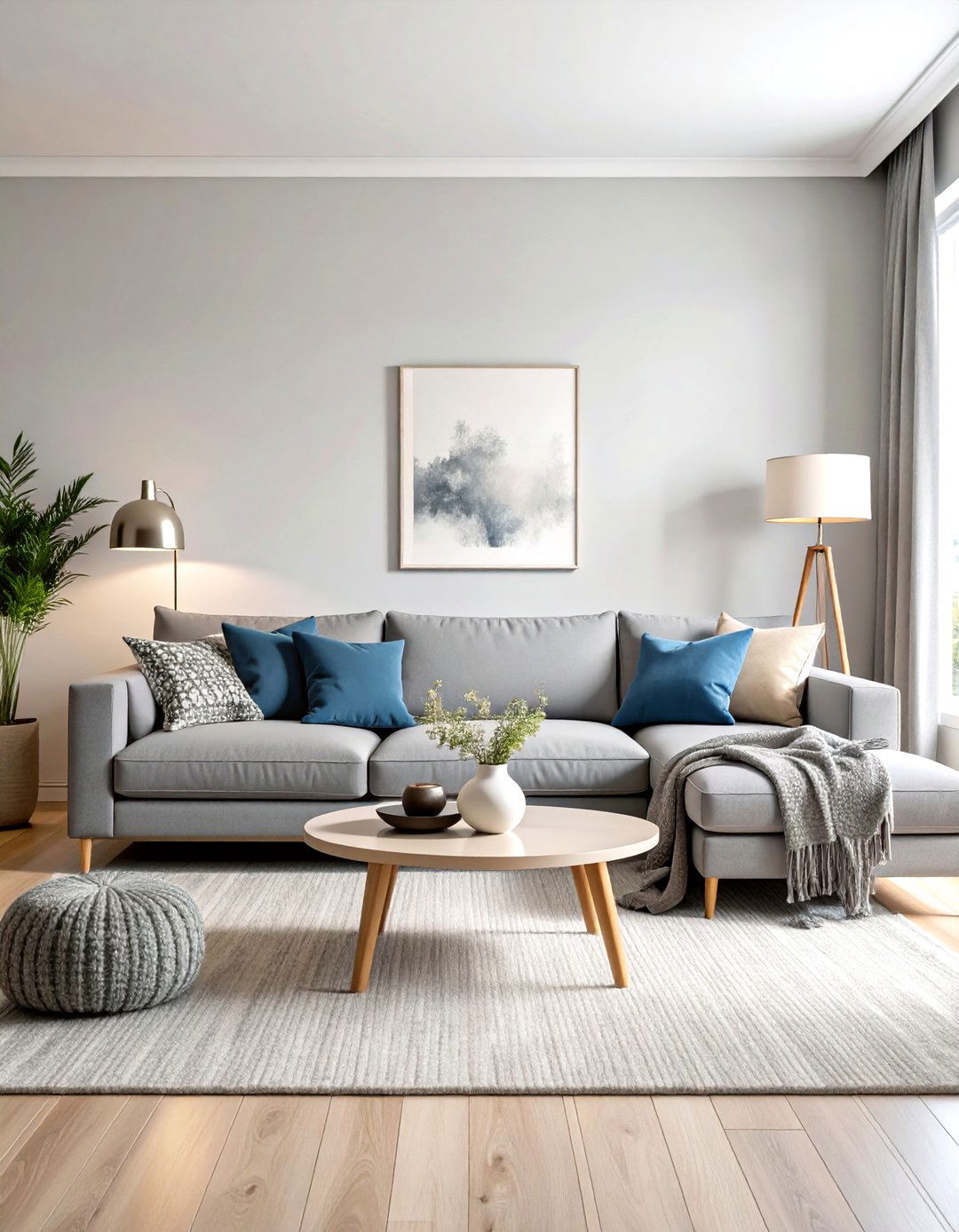
A monochromatic minimalist living room using varying shades of warm gray creates sophisticated depth while maintaining visual harmony throughout the space. This design concept layers charcoal sectional seating with lighter gray area rugs and mid-tone gray accent walls to establish a cohesive foundation. The furniture selection focuses on streamlined pieces with clean geometric shapes, including a rectangular coffee table and minimal floor lamps with brushed steel finishes. Textural variety becomes crucial in monochromatic schemes, incorporating soft velvet cushions, nubby wool throws, and smooth ceramic accessories in different gray tones. Strategic lighting includes recessed ceiling fixtures and table lamps that create ambient warmth against the cool color scheme. The result achieves contemporary elegance through careful curation of similar hues while avoiding monotony through thoughtful texture combinations and varying material finishes that add visual interest without introducing color complexity.
3. Minimalist Living Room with Floor-to-Ceiling Built-in Storage
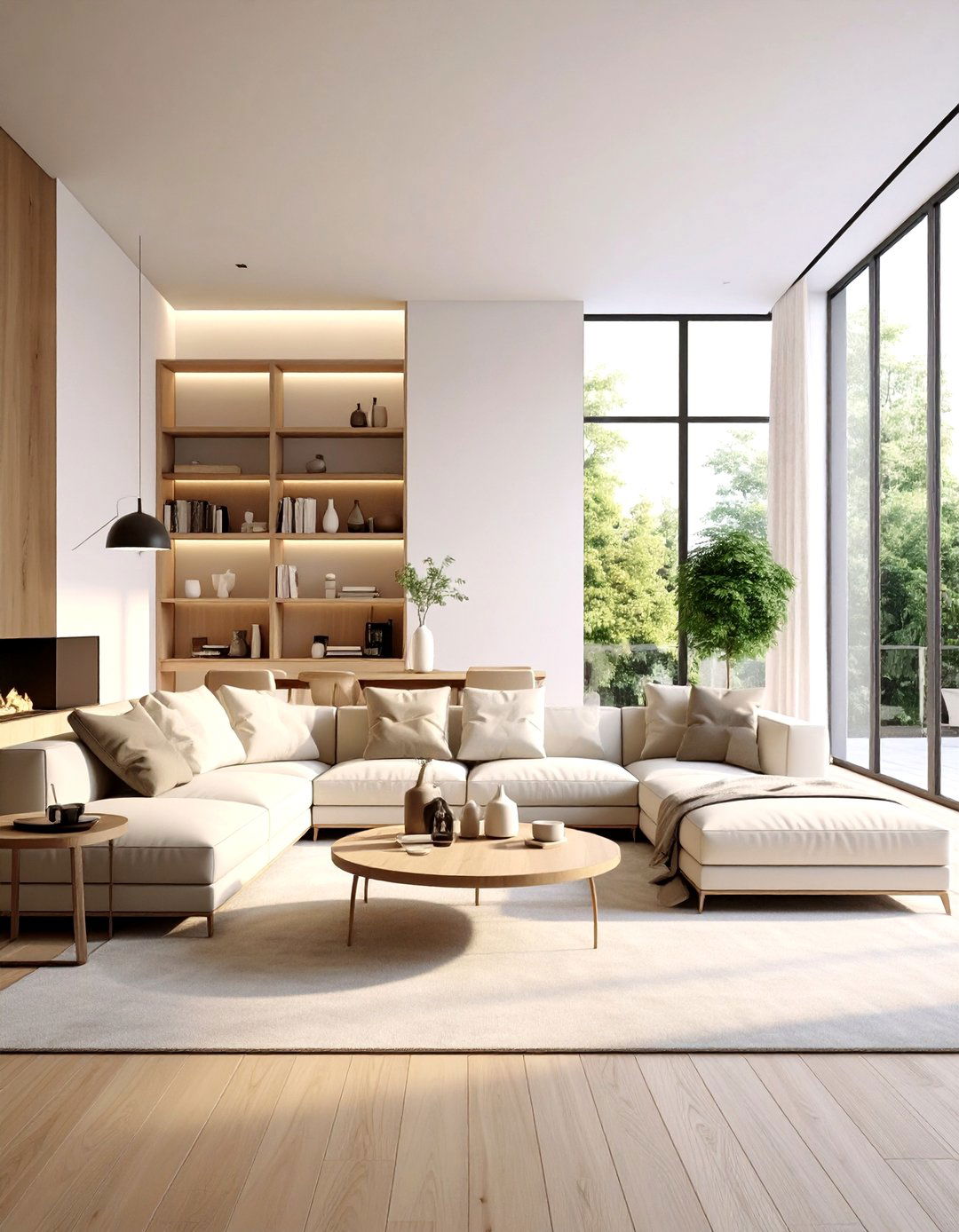
Designing a minimalist living room with integrated floor-to-ceiling storage maximizes functionality while maintaining clean aesthetic lines throughout the space. This approach features custom-built shelving units that span entire walls, providing ample storage behind sleek cabinet doors that blend seamlessly with wall colors. The remaining furniture stays deliberately minimal with a single sectional sofa, one coffee table, and carefully selected accent pieces that serve multiple purposes. The built-in storage eliminates visual clutter by concealing books, electronics, and personal items behind flush-mounted doors with hidden hardware. Lighting integration within the shelving units creates ambient illumination while highlighting displayed objects and architectural details. Color schemes typically favor whites and light woods to enhance the sense of spaciousness. This design theme proves that minimalist living rooms can accommodate substantial storage needs without compromising the essential principles of simplicity and visual calm that define contemporary minimalist aesthetics.
4. Japanese-Influenced Minimalist Living Room with Low Furniture
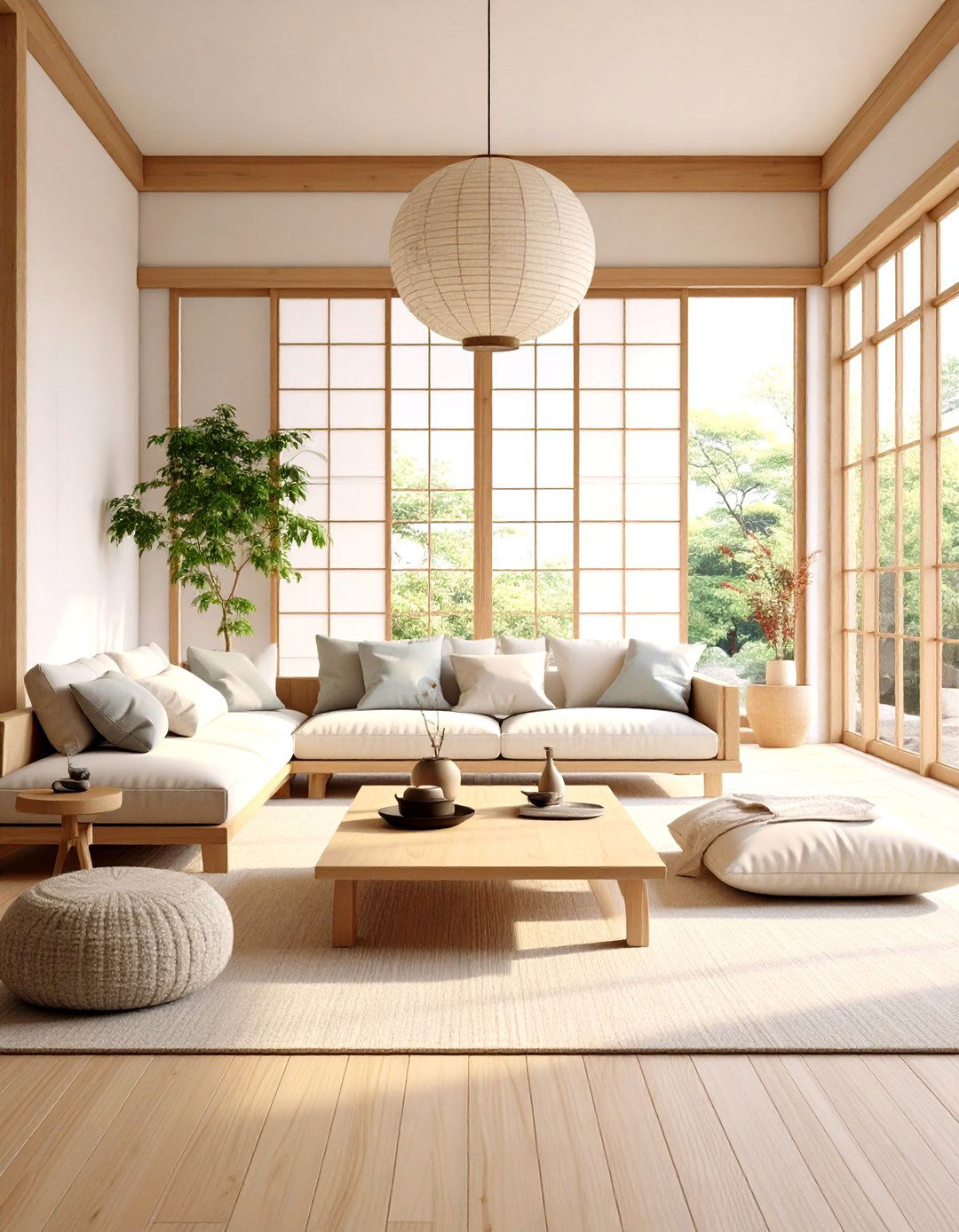
A Japanese-influenced minimalist living room embraces ground-level living through carefully selected low-profile furniture that creates intimate, contemplative spaces. This design philosophy centers around floor seating arrangements with low modular sofas, zabuton cushions, and a coffee table that sits close to the ground. Natural materials dominate the palette, featuring light wood floors, bamboo elements, and neutral textiles in organic cotton or linen fabrics. The color scheme remains earth-toned with whites, beiges, and soft greens that connect the interior to nature. Sliding panels or shoji screens can divide spaces while maintaining openness and flexibility. Lighting stays minimal with paper lanterns, floor lamps with wooden bases, and strategic natural light that filters through unadorned windows. This approach creates a meditative atmosphere that encourages mindfulness and relaxation while demonstrating how minimalist living rooms can reflect cultural design principles that prioritize simplicity and harmony with natural elements.
5. Open-Concept Minimalist Living Room with Flowing Layout
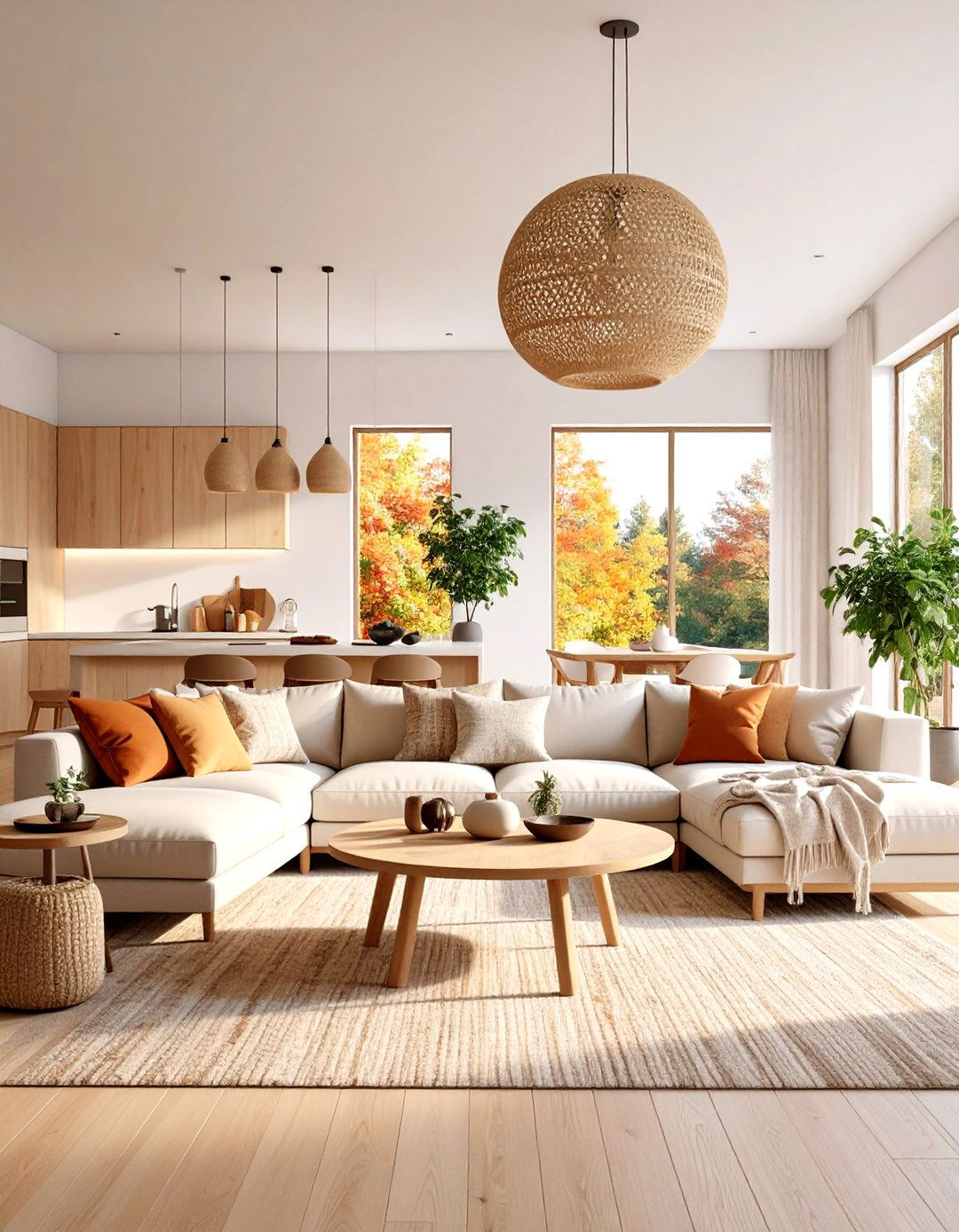
An open-concept minimalist living room design emphasizes fluid transitions between living, dining, and kitchen areas while maintaining distinct functional zones. This layout approach uses minimal furniture placement to create natural pathways and visual breathing room throughout the connected space. A large sectional sofa anchors the living area without blocking sightlines, while a sleek dining table and kitchen island maintain consistent material palettes. The color scheme unifies all areas through repeated neutral tones, typically featuring whites, warm grays, and natural wood accents that flow seamlessly between zones. Lighting design becomes crucial with pendant fixtures over the dining area, table lamps in the living space, and under-cabinet lighting in the kitchen creating layered illumination. Strategic area rugs define each functional space without creating visual barriers. This minimalist living room concept demonstrates how open floor plans can maintain the essential simplicity of minimalist design while accommodating modern lifestyle needs for connectivity and flexibility.
6. Minimalist Living Room with Statement Lighting and Neutral Palette
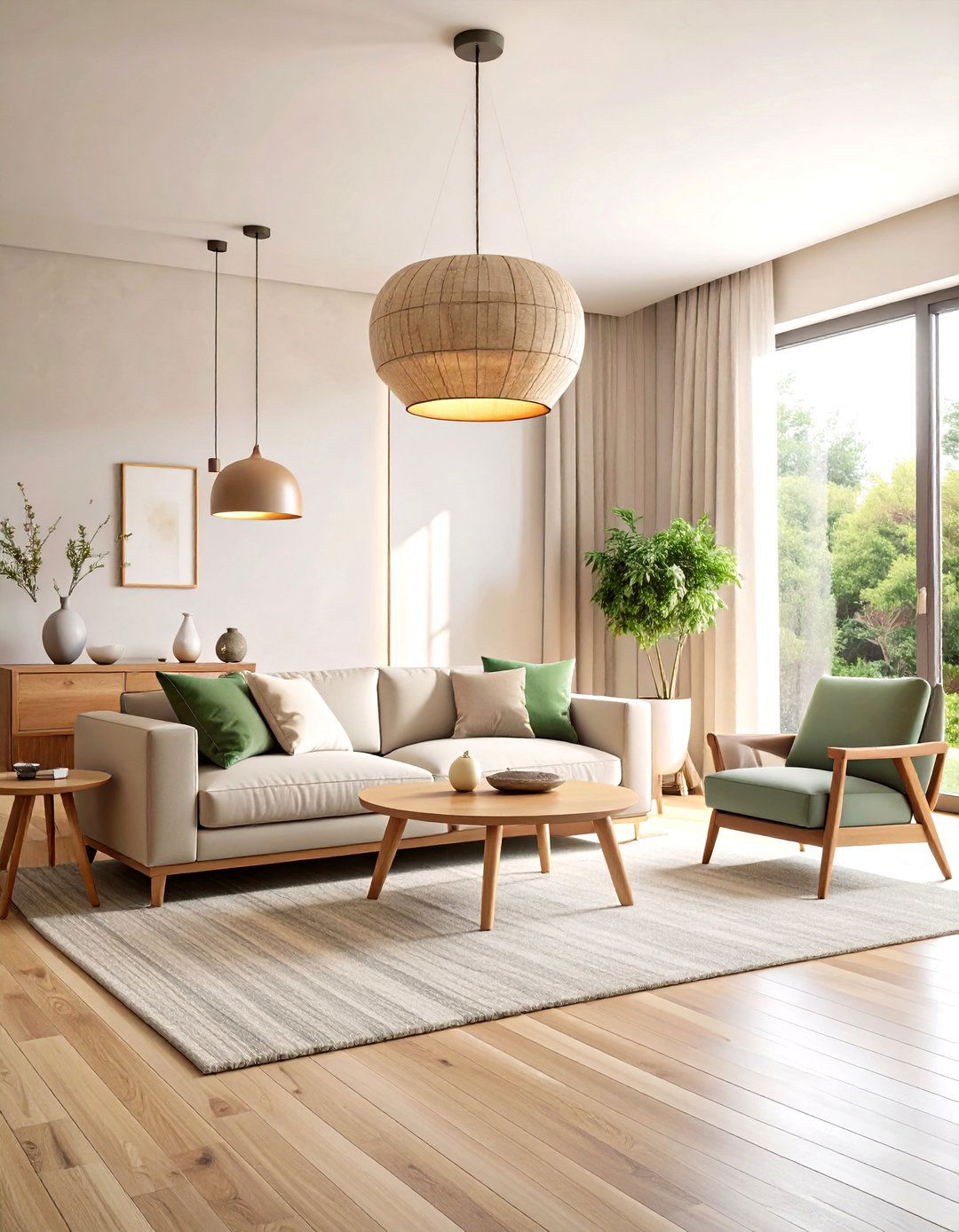
Creating a minimalist living room that features dramatic statement lighting while maintaining neutral color schemes demonstrates how focal points can enhance rather than overwhelm clean design principles. This approach centers around one significant lighting fixture, such as an oversized pendant light, sculptural floor lamp, or artistic chandelier that serves as functional art. The surrounding elements remain deliberately understated with neutral furniture in whites, beiges, or soft grays that allow the lighting to command attention. Seating arrangements typically include a streamlined sofa with minimal accent pieces that don't compete with the lighting focal point. Material selections favor natural textures like linen upholstery, wooden side tables, and stone or ceramic accessories that add subtle interest without introducing pattern or color complexity. The strategic placement of the statement lighting creates dramatic shadows and ambient illumination that transforms the mood throughout different times of day while maintaining the essential minimalist principle of purposeful design choices.
7. Textural Minimalist Living Room with Layered Natural Materials
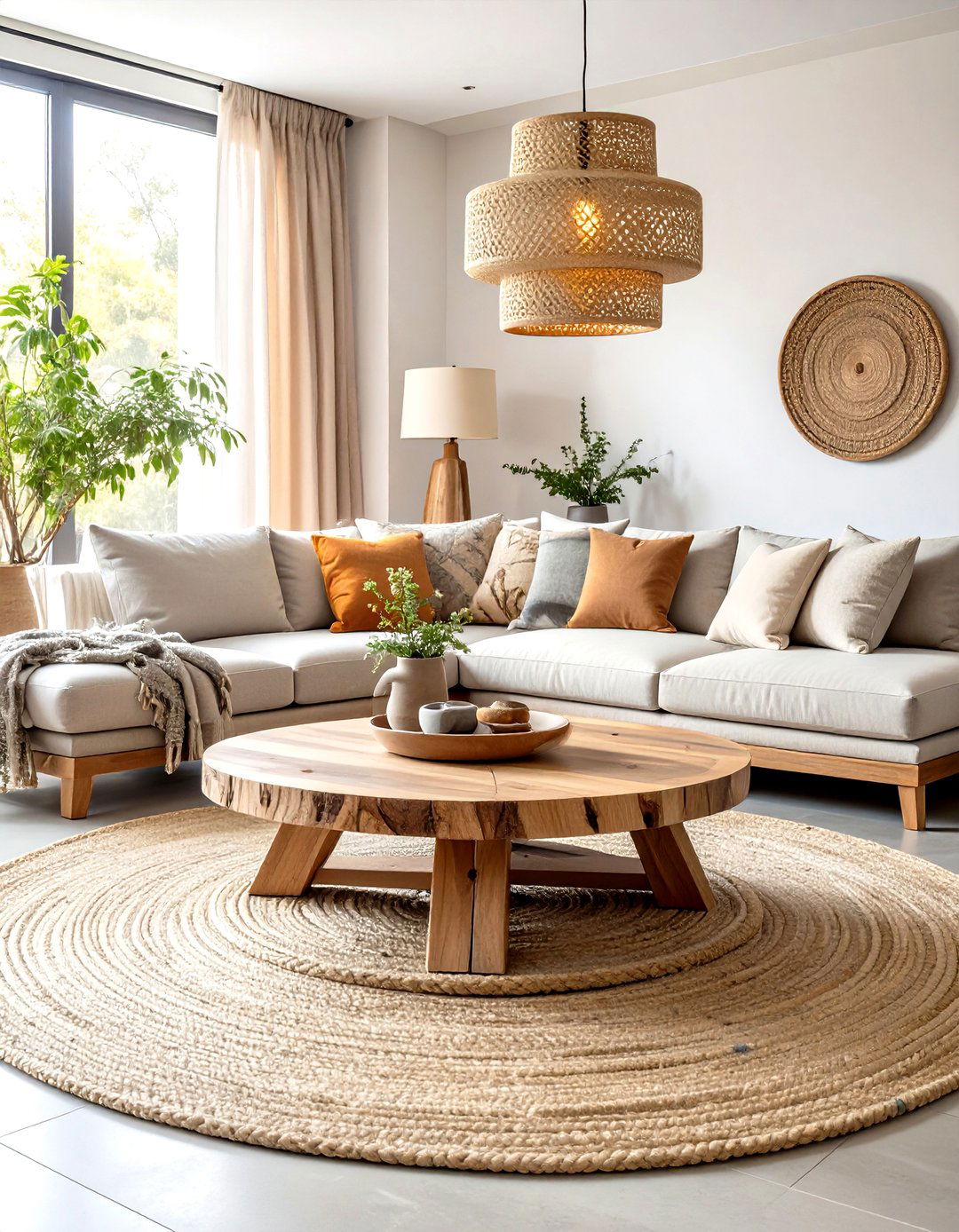
A textural minimalist living room combines various natural materials to create visual and tactile interest while adhering to neutral color palettes and clean design lines. This design concept layers different organic textures including rough-hewn wood coffee tables, smooth stone accent pieces, woven jute rugs, and soft linen upholstery that create depth without visual chaos. The furniture selection emphasizes pieces that showcase natural material qualities, such as live-edge wooden tables, stone-based lamps, and seating with exposed wooden frames. Color schemes remain earthy and muted, featuring creams, warm whites, and natural wood tones that highlight material variations rather than competing with them. Lighting design incorporates fixtures that complement the natural theme, such as pendant lights with wooden or stone elements and table lamps with ceramic bases. This approach proves that minimalist living rooms can achieve richness and warmth through thoughtful material selections while maintaining the essential simplicity that defines contemporary minimalist aesthetics and sustainable design principles.
8. Minimalist Living Room with Hidden Technology Integration
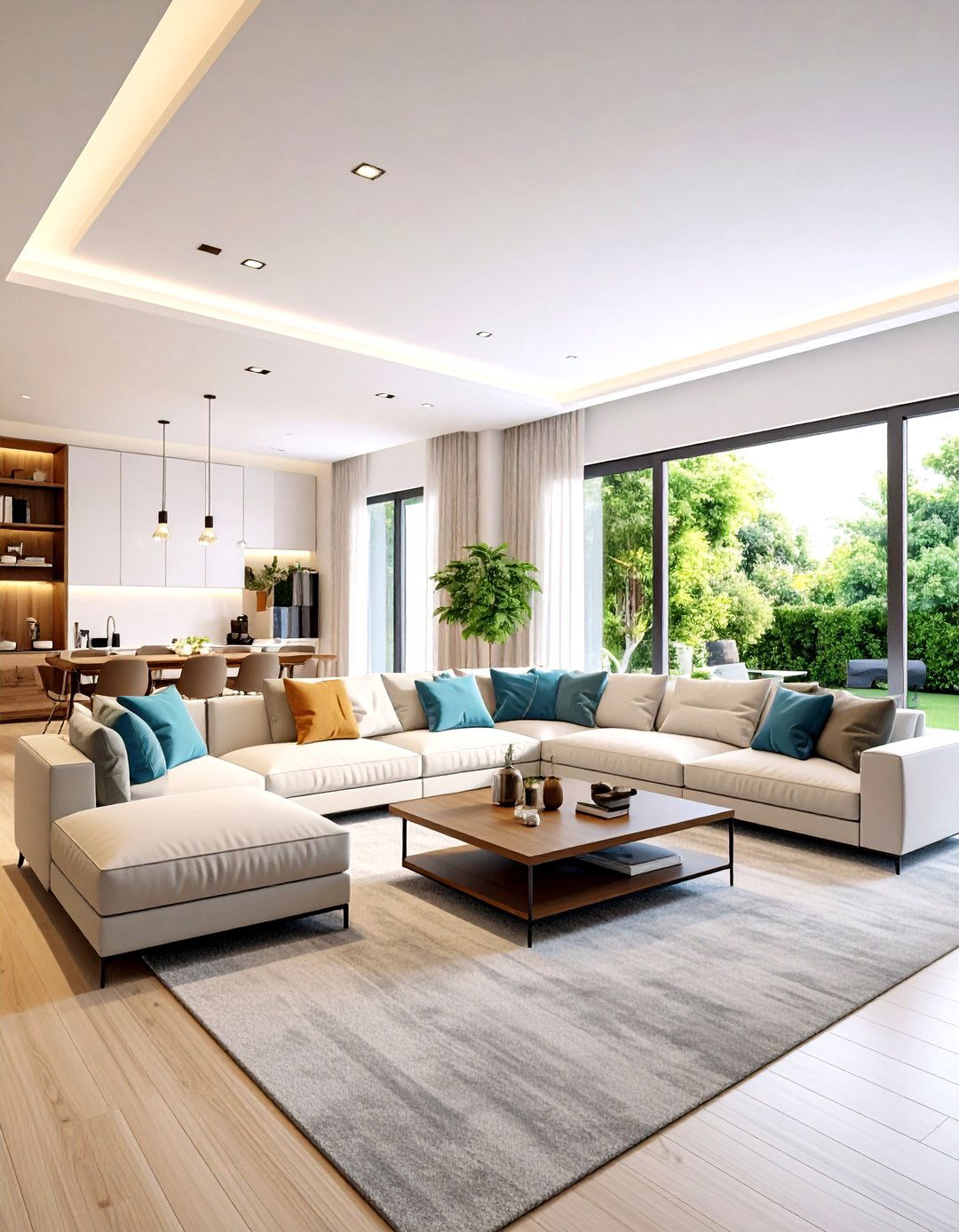
Designing a minimalist living room with seamlessly integrated technology maintains clean aesthetic lines while accommodating modern entertainment and connectivity needs. This concept features built-in media storage that conceals televisions, speakers, and gaming equipment behind sliding panels or cabinet doors that match surrounding wall finishes. Furniture selections include pieces with hidden charging stations, wireless charging surfaces, and cord management systems that eliminate visual clutter from electronic devices. The color palette typically emphasizes neutral tones that help technology elements blend into the background when not in use. Smart lighting systems allow for mood adjustment without visible controls, while motorized window treatments can be operated remotely. Seating arrangements consider optimal viewing angles while maintaining conversational layouts that don't revolve entirely around technology placement. This minimalist living room approach demonstrates how contemporary homes can embrace technological convenience without compromising the essential principles of simplicity and visual calm that define effective minimalist design in modern living spaces.
9. Modular Minimalist Living Room with Flexible Furniture Arrangements
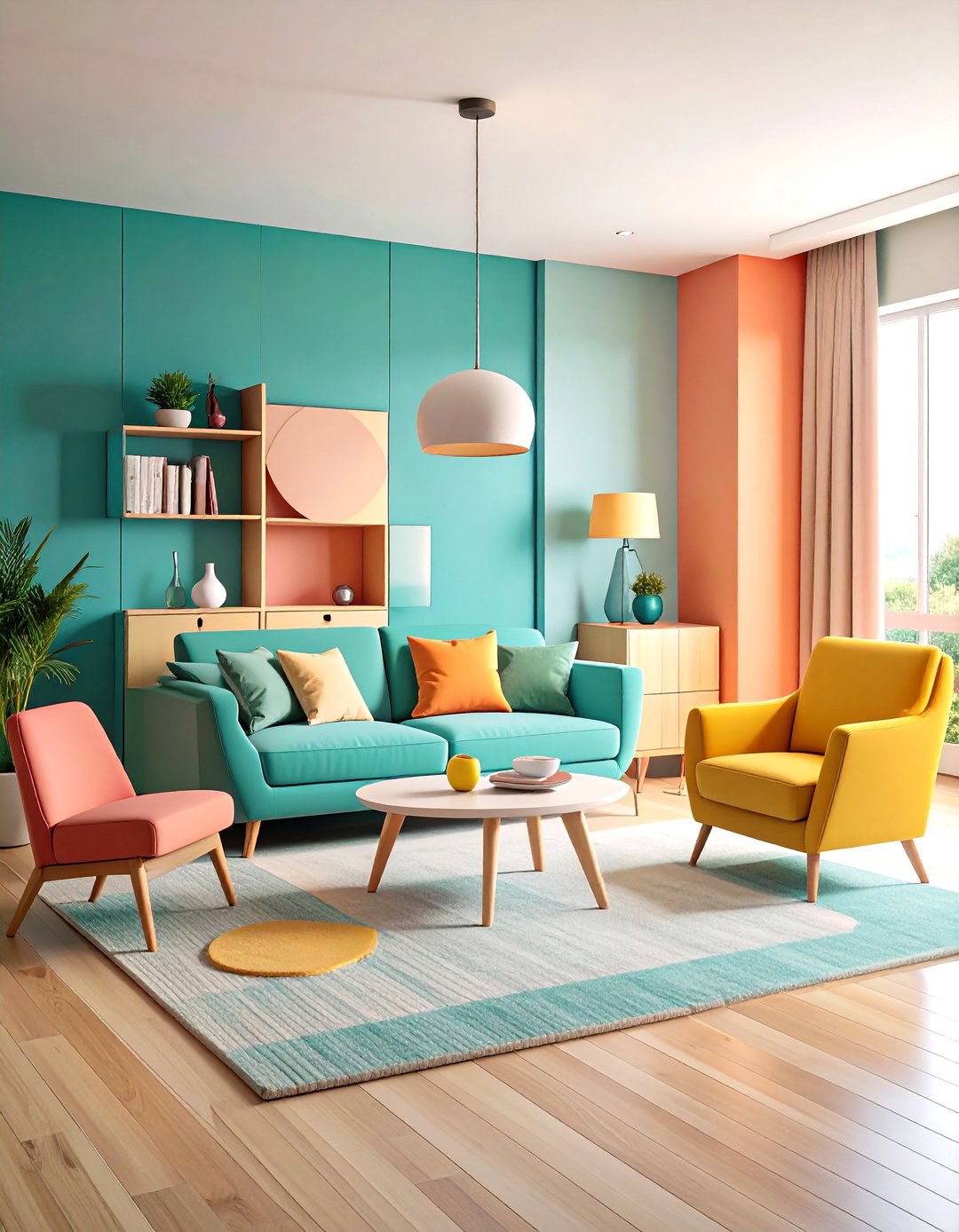
A modular minimalist living room utilizes adaptable furniture systems that can be reconfigured to meet changing needs while maintaining clean design principles throughout different arrangements. This approach centers around modular seating systems with individual pieces that combine into various configurations, from linear arrangements for entertaining to intimate conversation clusters for family time. Storage solutions include stackable cube units, nesting tables, and multi-functional pieces that serve different purposes as needs evolve. The color scheme remains consistent across all modular elements, typically featuring neutral tones that work together regardless of arrangement changes. Material selections favor durable, lightweight options that facilitate easy reconfiguration while maintaining aesthetic coherence. Lighting design incorporates portable elements like battery-powered table lamps and floor fixtures that can move with furniture arrangements. This minimalist living room concept addresses modern lifestyle flexibility while demonstrating how purposeful design choices can create spaces that adapt to different activities without requiring complete room redesigns or additional furniture purchases.
10. Minimalist Living Room with Dramatic Black and White Contrast
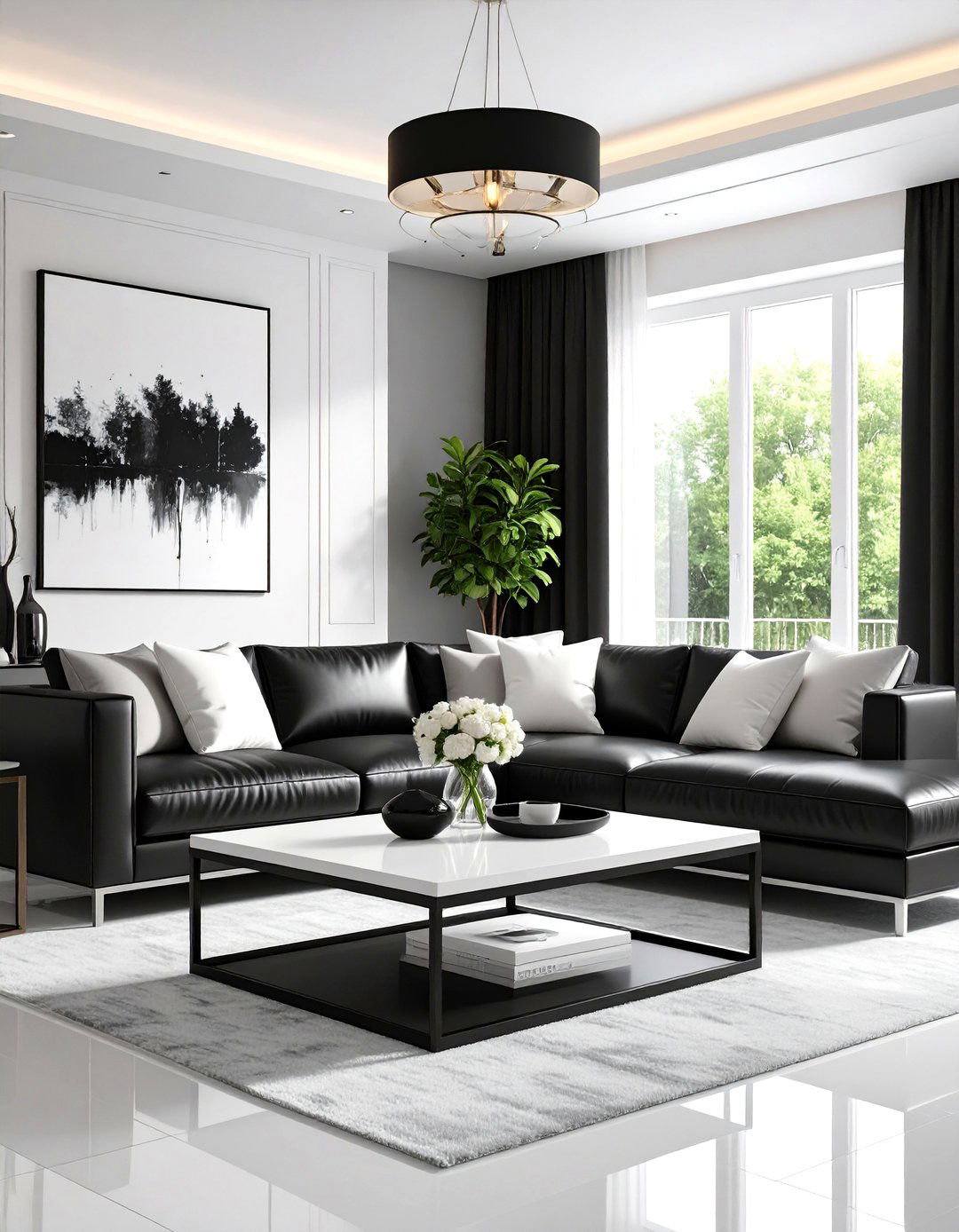
Creating a minimalist living room with high-contrast black and white elements demonstrates how bold color choices can enhance rather than overwhelm clean design principles. This design approach uses strategic placement of black furniture against white walls, or white seating with black accent pieces, to create visual drama while maintaining simplicity. Key furniture pieces might include a black leather sectional with white cushions, white coffee tables with black metal bases, or monochromatic artwork that reinforces the color scheme. Lighting becomes crucial for balancing the stark contrast, incorporating both warm and cool tones to prevent the space from feeling harsh or cold. Textural elements in neutral grays can bridge the contrast, including throws, rugs, and ceramic accessories that soften the dramatic color relationship. This minimalist living room concept proves that bold design choices can work within minimalist frameworks when applied thoughtfully, creating sophisticated spaces that feel both contemporary and timeless while maintaining the essential principles of purposeful simplicity.
11. Warm Minimalist Living Room with Earth-Tone Color Palette
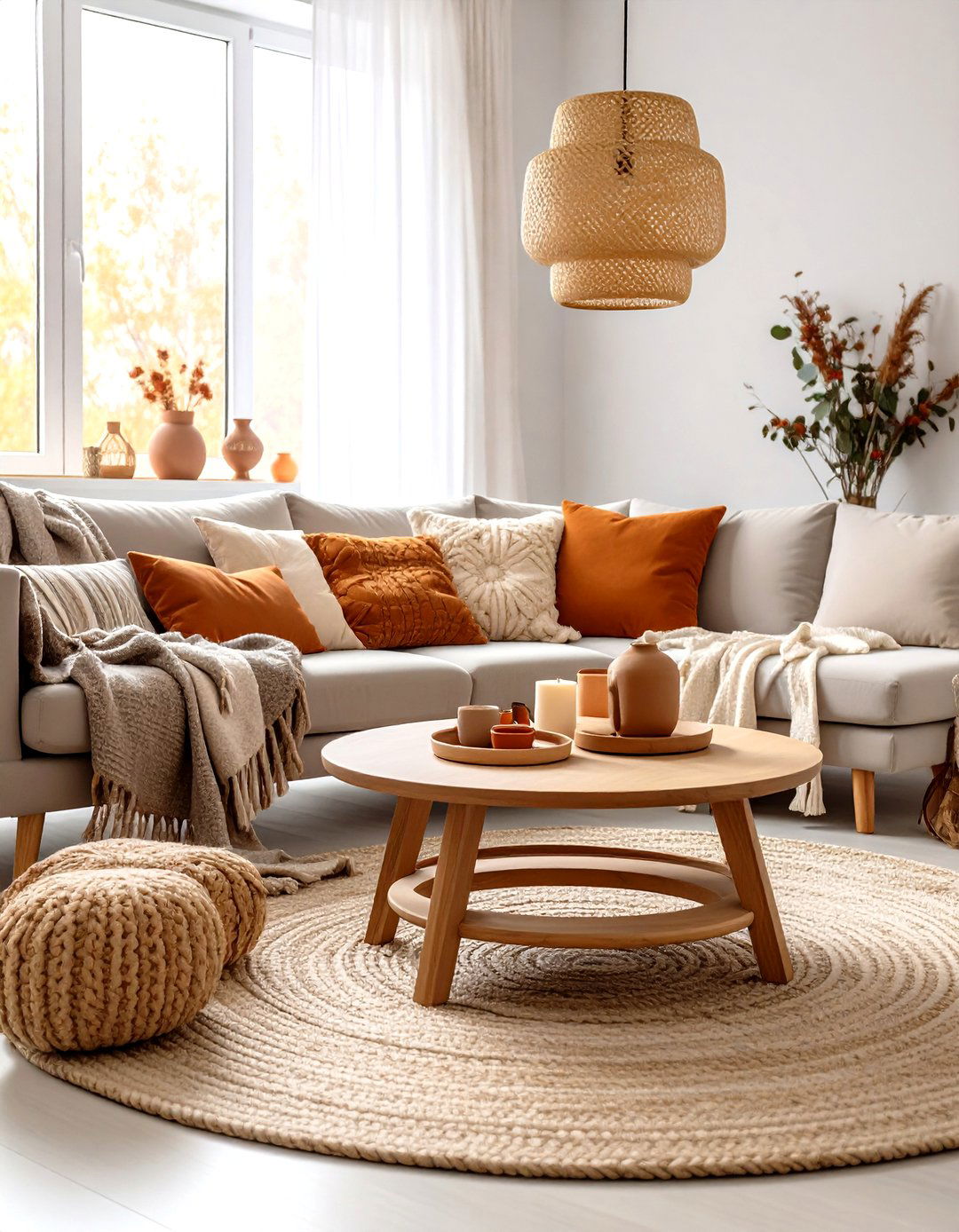
A warm minimalist living room incorporates earth-tone color palettes that create cozy, inviting atmospheres while maintaining the essential simplicity of minimalist design principles. This approach features furniture in warm beiges, soft taupes, and creamy whites that establish a comfortable foundation without overwhelming the space with color complexity. Natural materials play a crucial role, including wooden coffee tables with honey or walnut finishes, stone accent pieces, and ceramic accessories in terra cotta or sage tones. Textiles add warmth through cashmere throws, wool area rugs, and linen upholstery in muted earth tones that feel organic and comfortable. Lighting design emphasizes warm bulb temperatures and fixtures with brass or bronze finishes that complement the earth-tone palette. Plants become important accent elements, adding life and natural color variation while reinforcing the connection to organic materials. This minimalist living room concept demonstrates how color can create emotional warmth while adhering to principles of intentional design and visual simplicity.
12. Gallery-Style Minimalist Living Room with Curated Art Display
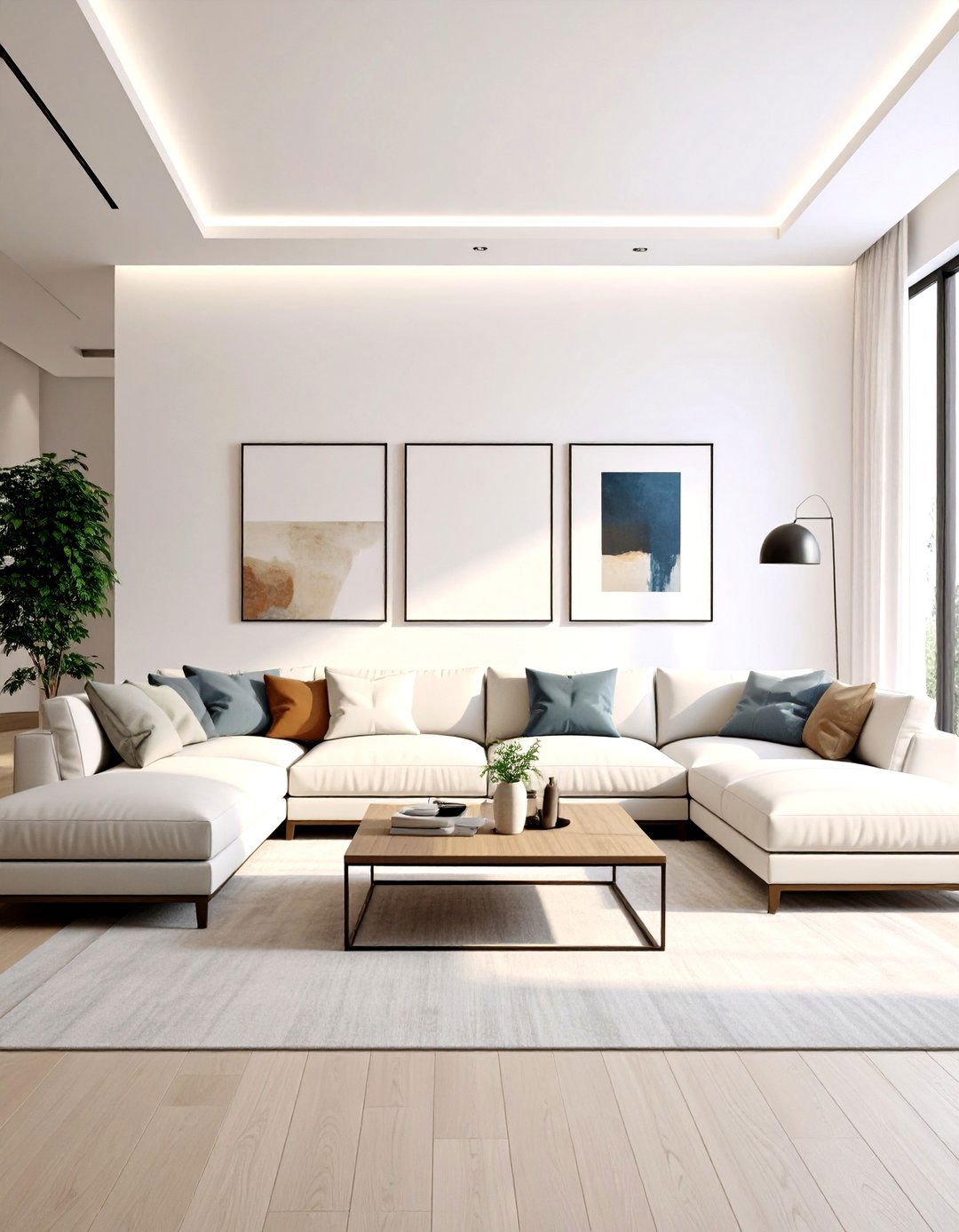
Designing a gallery-style minimalist living room focuses on creating museum-quality art display spaces while maintaining clean, uncluttered environments that showcase carefully selected pieces. This approach features minimal furniture arrangements that don't compete with artwork, typically including a streamlined sofa, simple coffee table, and strategic seating that allows for comfortable art viewing. Wall colors remain neutral, usually white or light gray, to provide optimal backdrops for art pieces without visual distraction. Lighting design becomes critical with track lighting, picture lights, or strategic spotlights that properly illuminate artwork while providing ambient room illumination. Storage solutions hide personal items behind closed cabinet systems, ensuring that displayed art remains the focal point without competing visual elements. Furniture selections favor clean lines and neutral colors that complement rather than compete with artistic elements. This minimalist living room concept proves that art appreciation and minimalist design principles can work together to create sophisticated spaces that feel both culturally enriching and serenely organized.
13. Minimalist Living Room with Indoor Garden Features
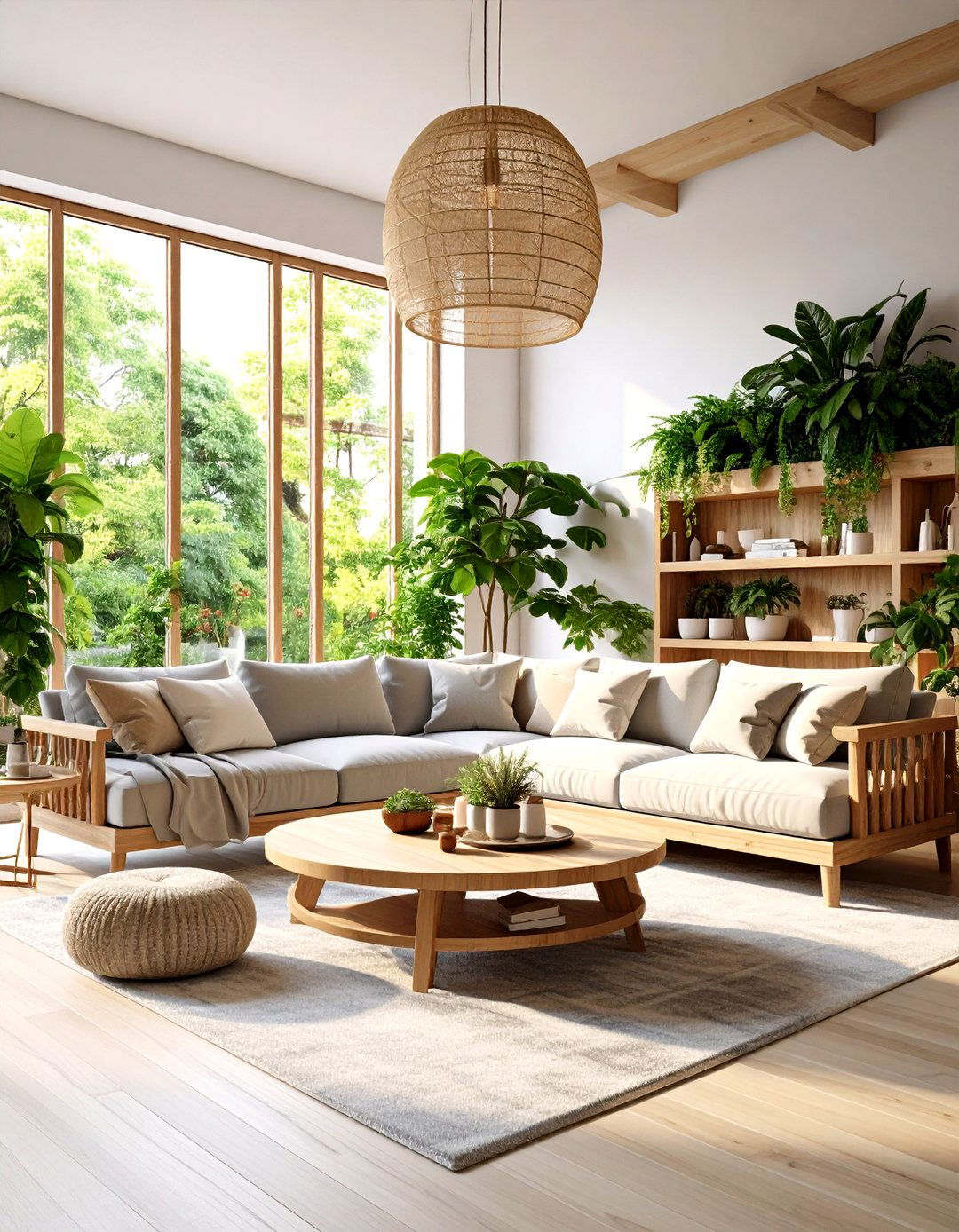
Creating a minimalist living room with integrated indoor garden elements brings natural beauty into clean design spaces while maintaining the essential simplicity of contemporary minimalist aesthetics. This concept incorporates built-in planters, living walls, or strategically placed large plants that serve as natural focal points without creating visual clutter. Furniture selections complement the organic elements with natural materials like wooden coffee tables, stone accent pieces, and neutral textiles that harmonize with plant life. The color palette emphasizes earth tones and natural greens that support the garden theme while maintaining neutral foundations. Lighting design accommodates both human comfort and plant health through full-spectrum LED systems and strategic natural light placement. Air purification becomes a functional benefit as plants improve indoor air quality while serving aesthetic purposes. Maintenance considerations influence plant selections toward low-maintenance varieties that thrive in indoor conditions without requiring extensive care systems that would compromise the clean aesthetic essential to effective minimalist design principles.
14. Minimalist Living Room with Fireplace as Central Feature
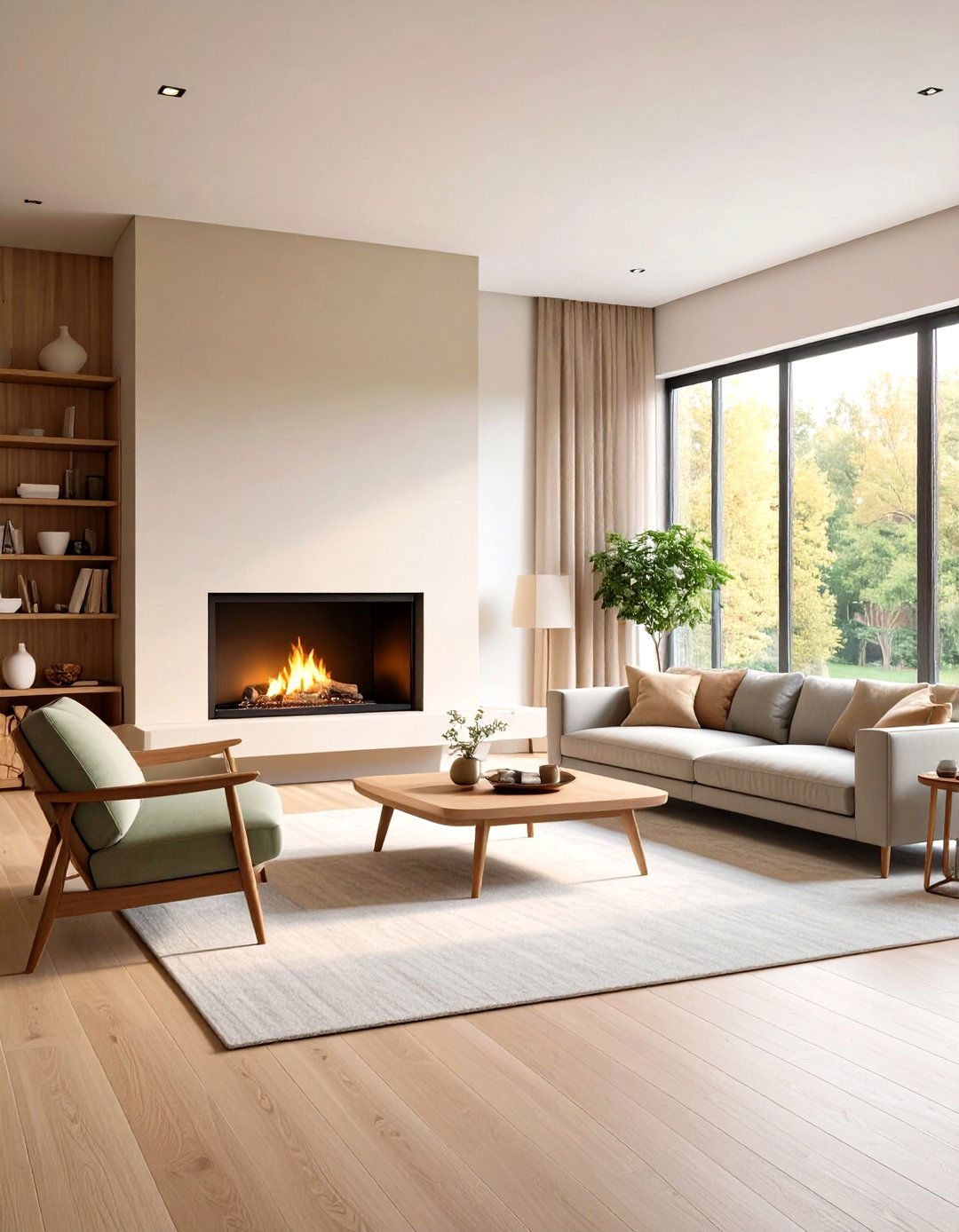
A minimalist living room designed around a central fireplace creates a warm focal point while maintaining clean design principles and functional furniture arrangements. This approach treats the fireplace as both heating element and architectural feature, often incorporating modern, streamlined fireplace designs that complement minimalist aesthetics rather than traditional ornate mantels. Seating arrangements create conversation areas that take advantage of fireplace warmth while maintaining sight lines and traffic flow throughout the space. The color palette typically emphasizes neutrals that complement fireplace materials, whether stone, concrete, or metal finishes. Built-in storage near the fireplace can accommodate firewood, accessories, or entertainment equipment without creating visual clutter. Lighting design works with firelight to create layered illumination that enhances the cozy atmosphere without competing with the fireplace glow. This minimalist living room concept demonstrates how traditional comfort elements can be incorporated into contemporary design frameworks while maintaining the essential principles of simplicity and purposeful furniture placement that define effective minimalist interior design.
15. Minimalist Living Room with Multi-Functional Ottoman Storage
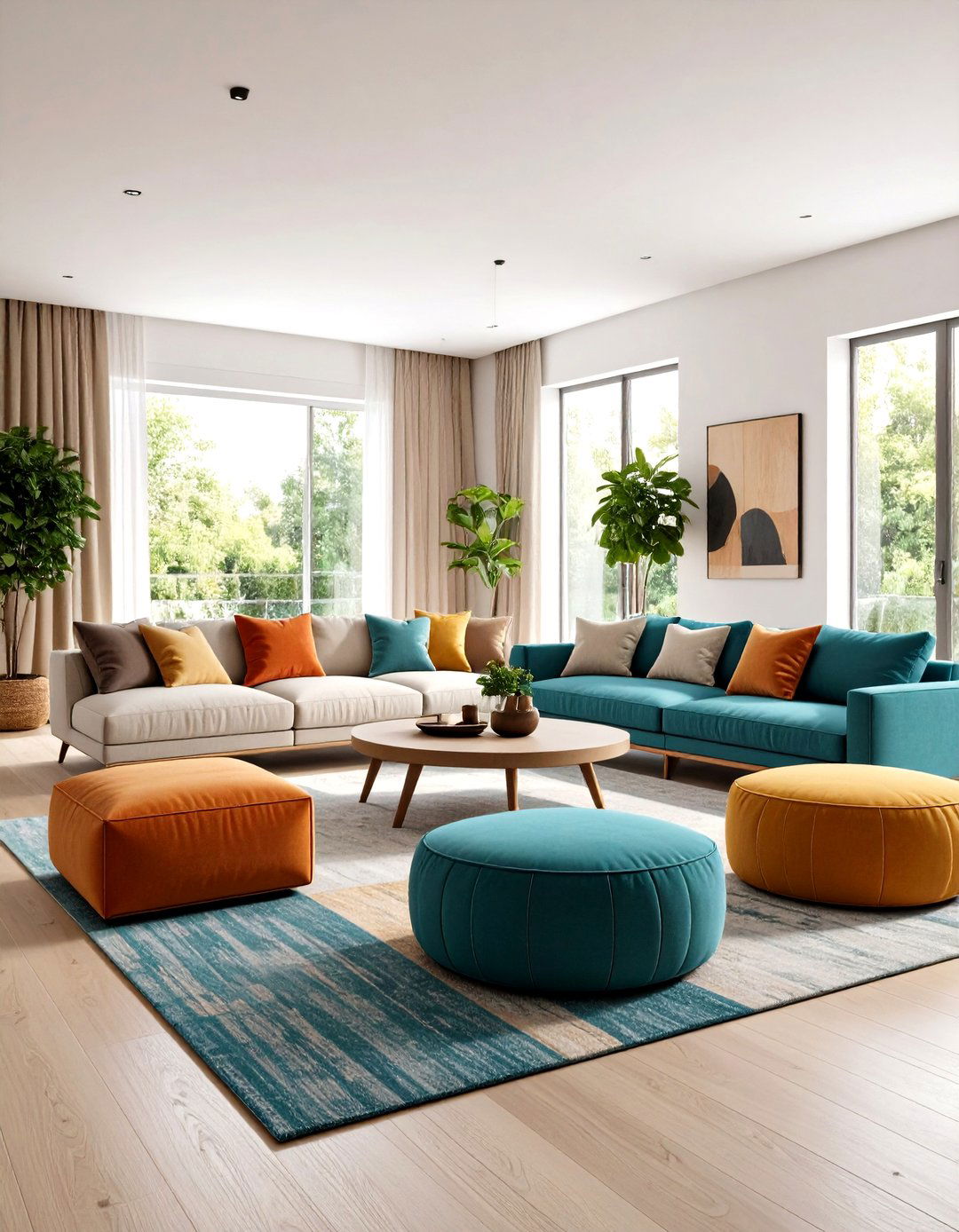
Designing a minimalist living room with multi-functional ottoman storage demonstrates how furniture can serve multiple purposes while maintaining clean aesthetic lines and organized living spaces. This concept features oversized ottomans that provide seating, footrests, coffee table surfaces, and hidden storage for throws, books, or seasonal items. The furniture arrangement treats ottomans as central elements that can be moved and reconfigured based on different activities or entertaining needs. Material selections typically favor neutral upholstery in durable fabrics like linen or performance textiles that can withstand regular use while maintaining visual appeal. The color palette remains consistent with other minimalist principles, featuring whites, grays, or earth tones that work with various room configurations. Additional seating includes streamlined sofas or chairs that complement the ottoman-centered arrangement without overwhelming the space. This minimalist living room approach proves that functional furniture choices can enhance rather than compromise design simplicity while providing practical solutions for modern living needs and storage requirements.
16. Minimalist Living Room with Floor-to-Ceiling Windows
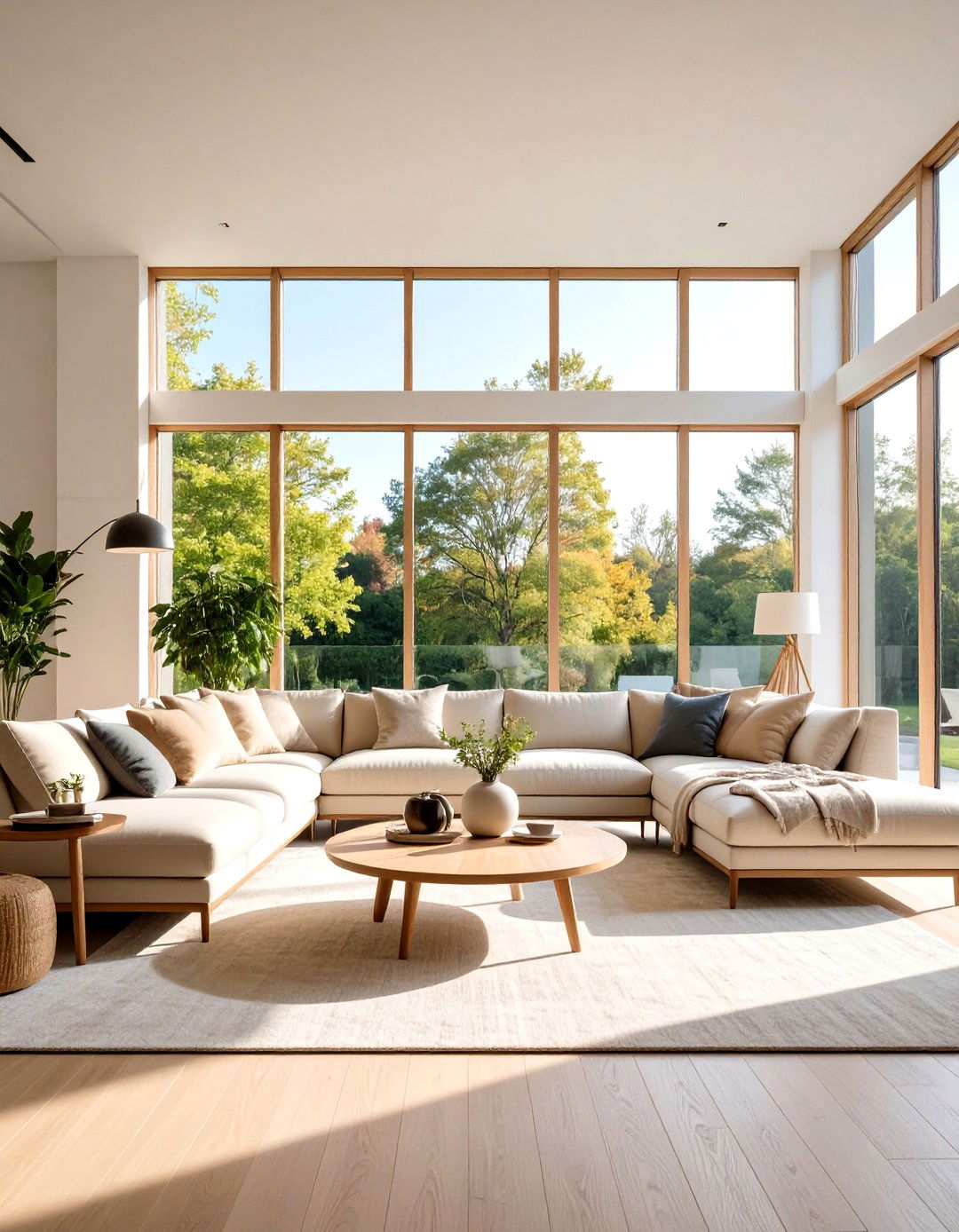
Creating a minimalist living room with floor-to-ceiling windows maximizes natural light while maintaining clean design principles that complement architectural openness and connection to outdoor views. This design approach treats windows as primary design elements, arranging furniture to take advantage of natural light and outdoor vistas without blocking sight lines. Window treatments remain minimal, often featuring simple panels in neutral fabrics or motorized blinds that can disappear when not needed. Furniture selections consider the abundant light, typically including pieces that won't fade or deteriorate from sun exposure while maintaining comfortable seating arrangements. The color palette emphasizes light, neutral tones that reflect and amplify natural illumination throughout different times of day. Artificial lighting becomes supplement rather than primary illumination, featuring table lamps and accent lighting that enhance rather than compete with natural light sources. This minimalist living room concept demonstrates how architectural features can drive design decisions while maintaining the essential principles of simplicity and intentional furniture placement that characterize effective contemporary minimalist interiors.
17. Minimalist Living Room with Curved Furniture and Organic Shapes
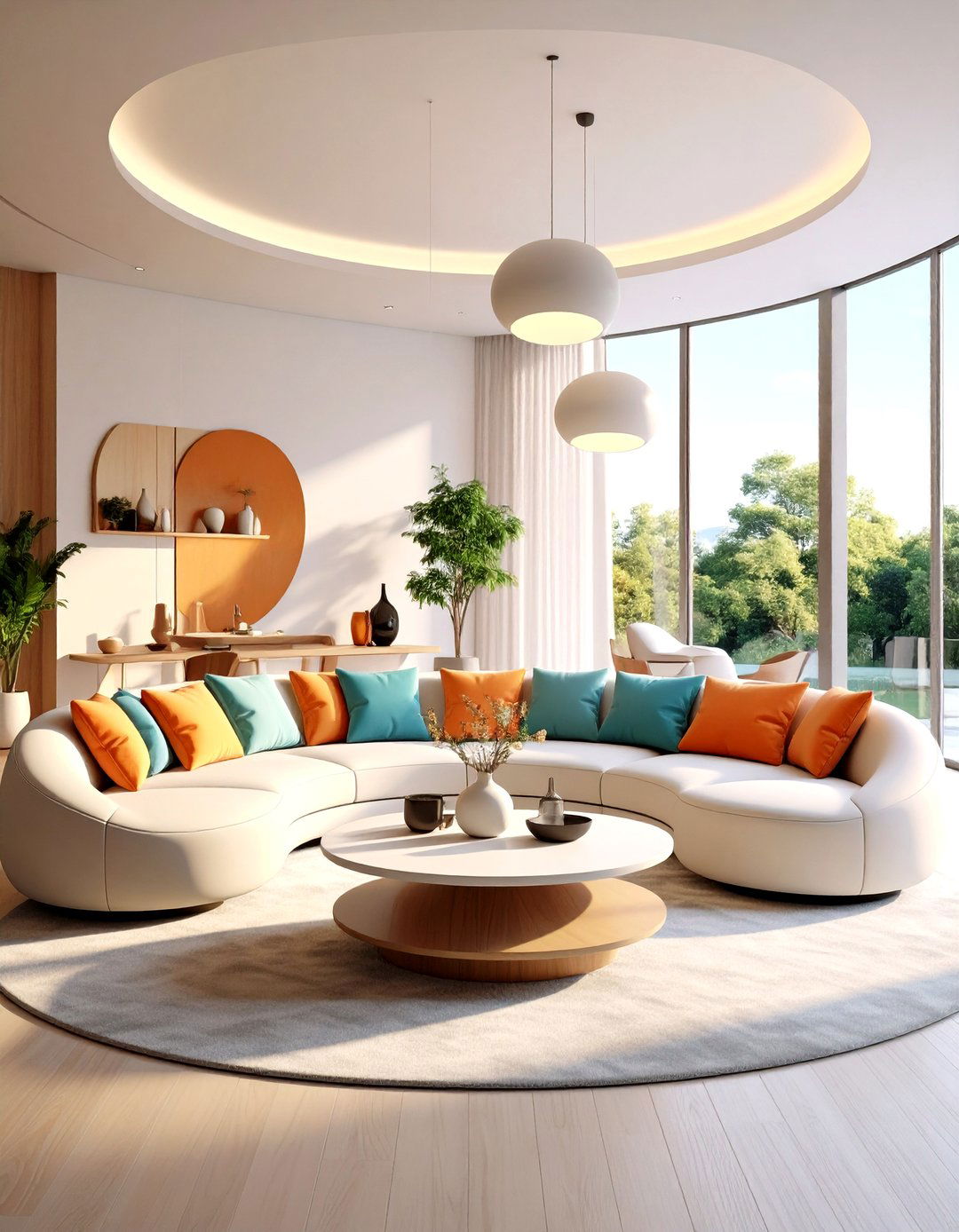
A minimalist living room featuring curved furniture and organic shapes creates visual softness while maintaining contemporary design principles and functional living arrangements. This approach incorporates sofas with rounded corners, circular coffee tables, and curved accent chairs that contrast with traditional angular minimalist furniture while keeping clean lines. The organic shapes create visual flow and movement within the space while maintaining the essential simplicity that defines minimalist design principles. Color palettes typically favor neutral tones that emphasize form over pattern, allowing the curved furniture shapes to become primary design elements. Lighting fixtures can echo the organic theme with pendant lights featuring rounded forms or table lamps with sculptural curved bases. Material selections often include soft textiles and smooth finishes that complement the rounded furniture forms while maintaining durability and comfort. This minimalist living room concept demonstrates how contemporary design trends toward organic shapes can be incorporated into minimalist frameworks while maintaining the essential principles of intentional design choices and visual simplicity that create serene, functional living spaces.
18. Minimalist Living Room with Neutral Textiles and Pattern Play
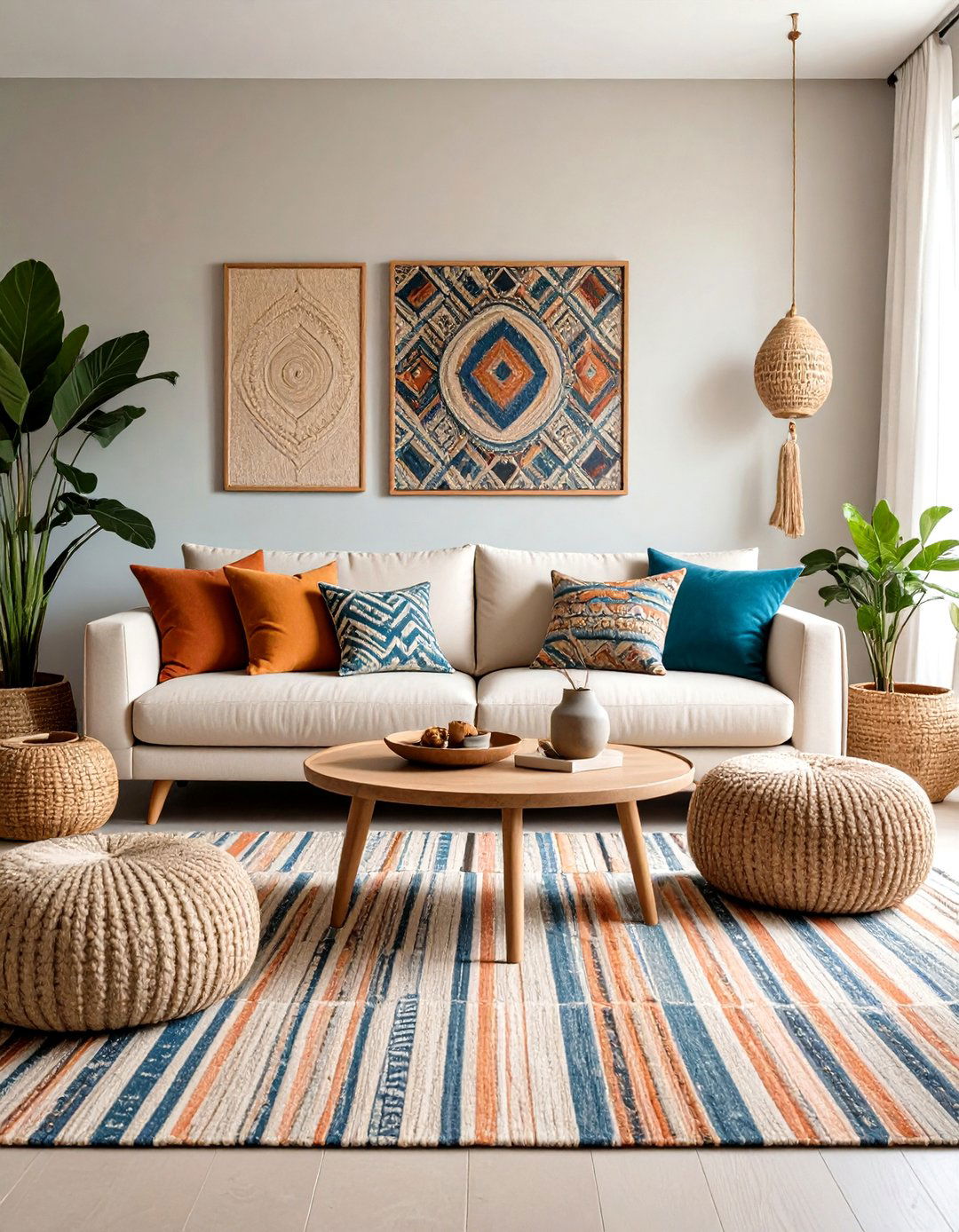
Designing a minimalist living room with carefully curated neutral textiles and subtle pattern play adds visual interest while maintaining the essential simplicity of contemporary minimalist design principles. This approach incorporates geometric patterns, natural textures, and tonal variations within neutral color schemes that create depth without overwhelming clean aesthetic lines. Textile selections might include striped area rugs, textured throw pillows, and woven wall hangings that introduce pattern through natural materials rather than bold colors. The furniture serves as neutral foundation with solid-colored upholstery that allows textile patterns to provide visual focal points. Pattern coordination remains subtle, often featuring similar scales or complementary geometric forms that work together without creating visual competition. Lighting design highlights textile textures through strategic placement that creates shadows and depth. This minimalist living room concept proves that pattern and texture can enhance rather than compromise minimalist aesthetics when applied thoughtfully, creating spaces that feel both visually interesting and serenely organized while maintaining the essential principles of purposeful design choices.
19. Minimalist Living Room with Smart Storage and Hidden Compartments
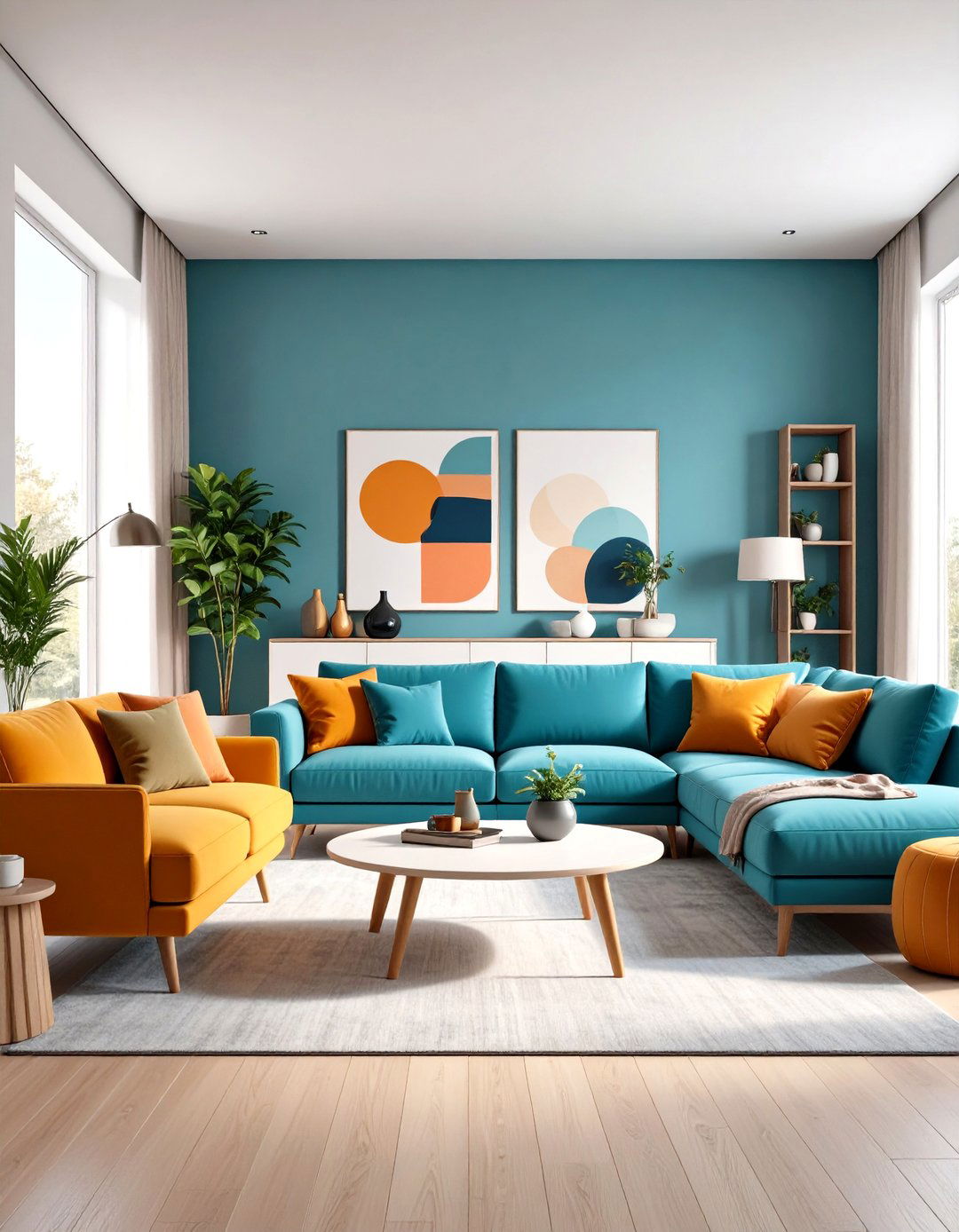
Creating a minimalist living room with intelligent storage solutions and hidden compartments maintains clutter-free surfaces while accommodating modern lifestyle storage needs and electronic equipment. This design concept features furniture with built-in storage compartments, including coffee tables with lift-top surfaces, sofas with hidden storage beneath cushions, and entertainment centers that completely conceal technology when not in use. Wall-mounted storage systems disappear into wall finishes, providing book storage, display space, and equipment housing without visible hardware or obvious storage indicators. The color palette remains consistently neutral to help storage elements blend seamlessly into the overall design scheme. Lighting can be integrated into storage systems, providing illumination for functional use while maintaining ambient room lighting. Organization systems within hidden storage ensure that items remain accessible while supporting the minimalist principle of clear surfaces and visual simplicity. This minimalist living room approach demonstrates how contemporary storage technology can support minimalist design goals while providing practical solutions for modern living requirements and lifestyle demands.
20. Minimalist Living Room with Sustainable Materials and Eco-Friendly Design
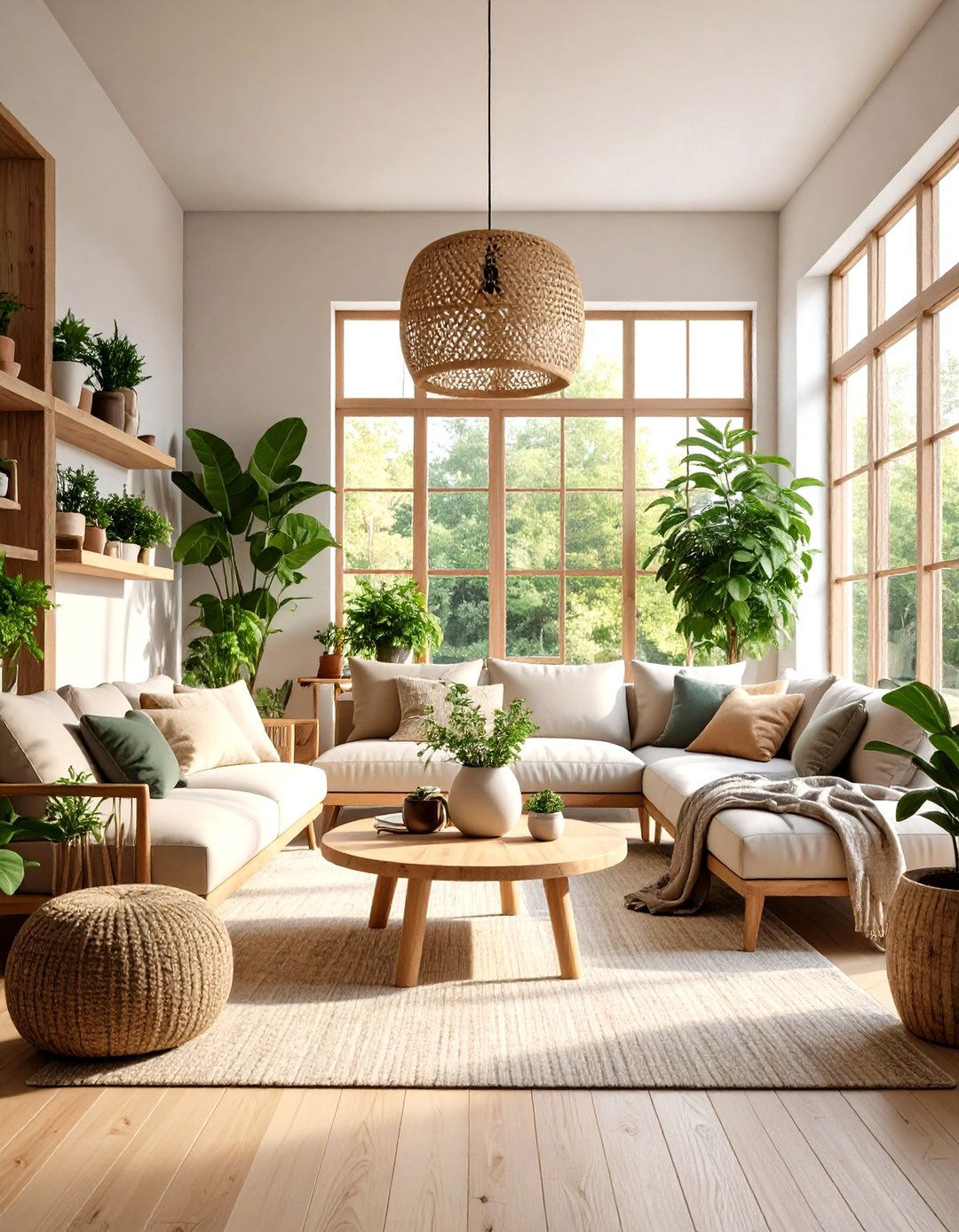
Designing a minimalist living room with sustainable materials and eco-friendly principles demonstrates how environmental consciousness can enhance rather than compromise contemporary minimalist design aesthetics. This approach prioritizes furniture made from reclaimed wood, recycled metals, and certified sustainable materials that support both environmental goals and design simplicity. The color palette emphasizes natural material colors, featuring unpainted woods, natural fiber textiles, and stone elements that showcase inherent beauty without additional chemical finishes. Furniture selections favor high-quality pieces designed for longevity rather than trends, supporting the minimalist principle of investing in fewer, better items. Energy-efficient lighting systems, including LED fixtures and smart controls, reduce environmental impact while providing optimal illumination. Air quality improvements come through natural ventilation, non-toxic materials, and strategically placed plants that filter indoor air. This minimalist living room concept proves that sustainability and minimalism share common values of intentional consumption, quality over quantity, and respect for natural materials while creating beautiful, functional spaces that support both personal wellbeing and environmental responsibility.
Conclusion:
These 20 minimalist living room ideas demonstrate that contemporary minimalist design has evolved into a rich, diverse approach that embraces warmth, functionality, and personal expression while maintaining essential principles of simplicity and intentional living. From sustainable materials and smart storage solutions to dramatic lighting and organic shapes, each concept proves that minimalist spaces can be both visually striking and deeply comfortable. The key lies in thoughtful curation, quality over quantity, and creating spaces that truly serve your lifestyle needs. Whether you're drawn to Scandinavian warmth, Japanese-influenced tranquility, or high-contrast drama, minimalist design offers endless possibilities for creating serene, clutter-free living spaces that feel both modern and timeless. These ideas provide the foundation for transforming any living room into a peaceful retreat that celebrates the beauty of simplicity.


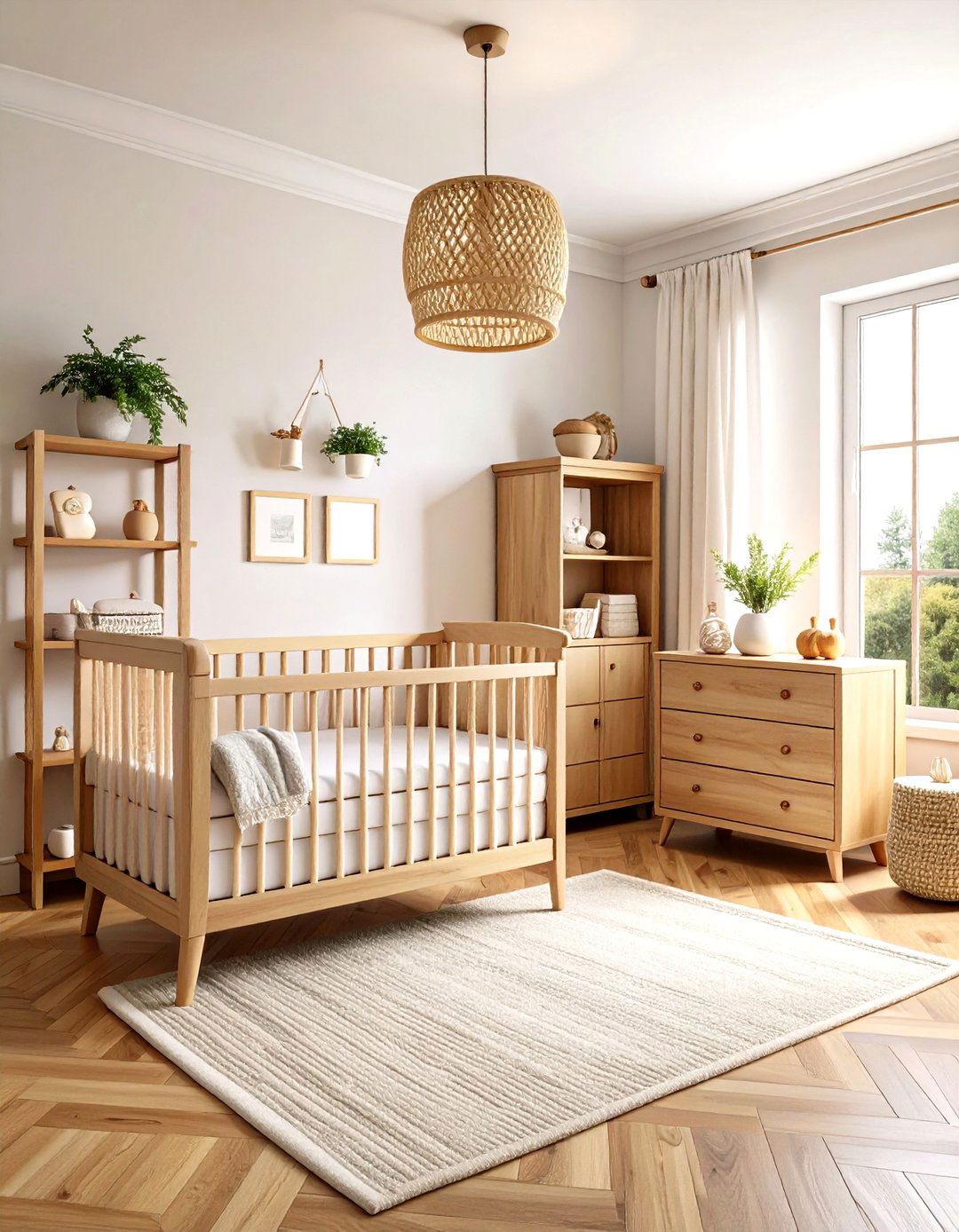
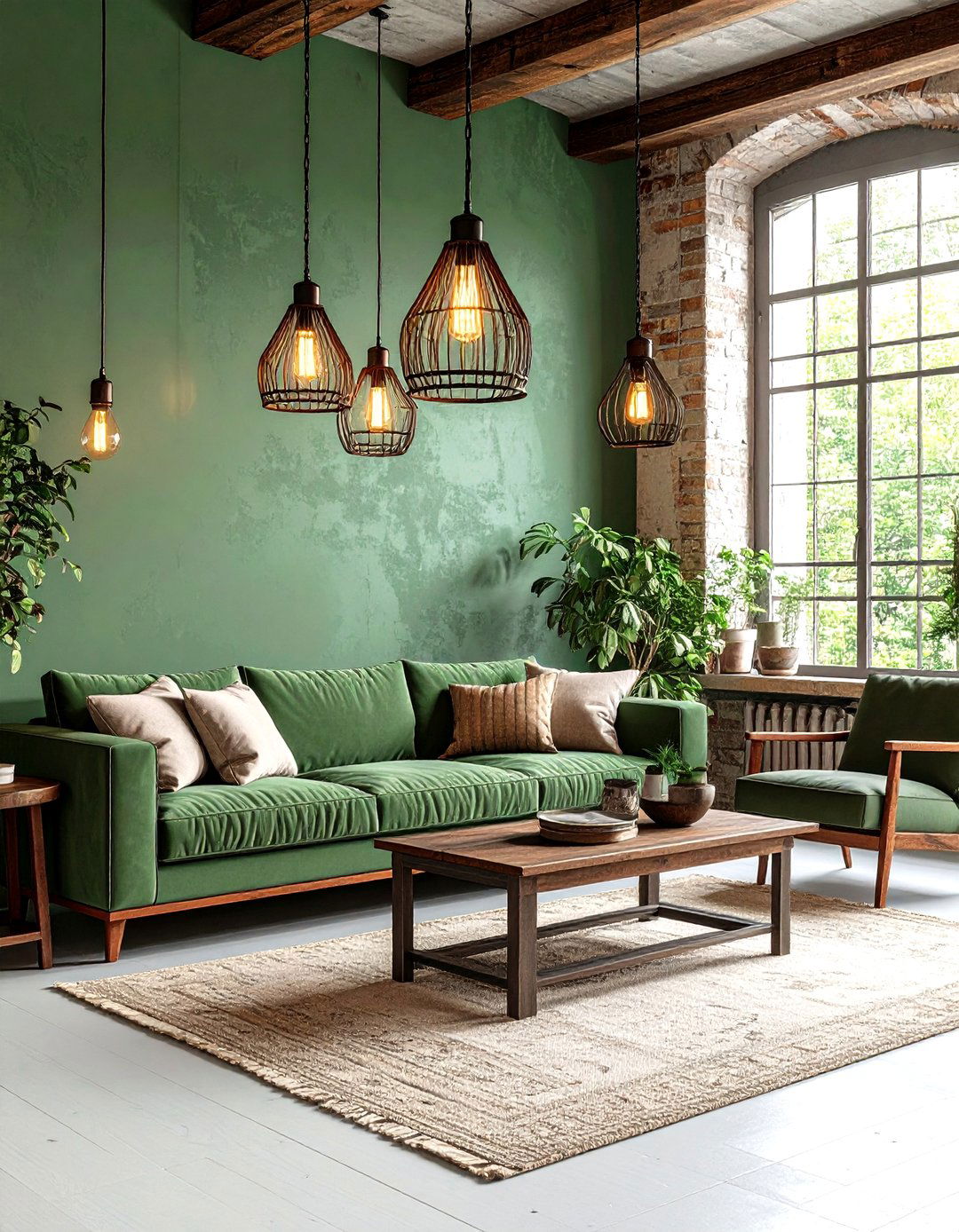
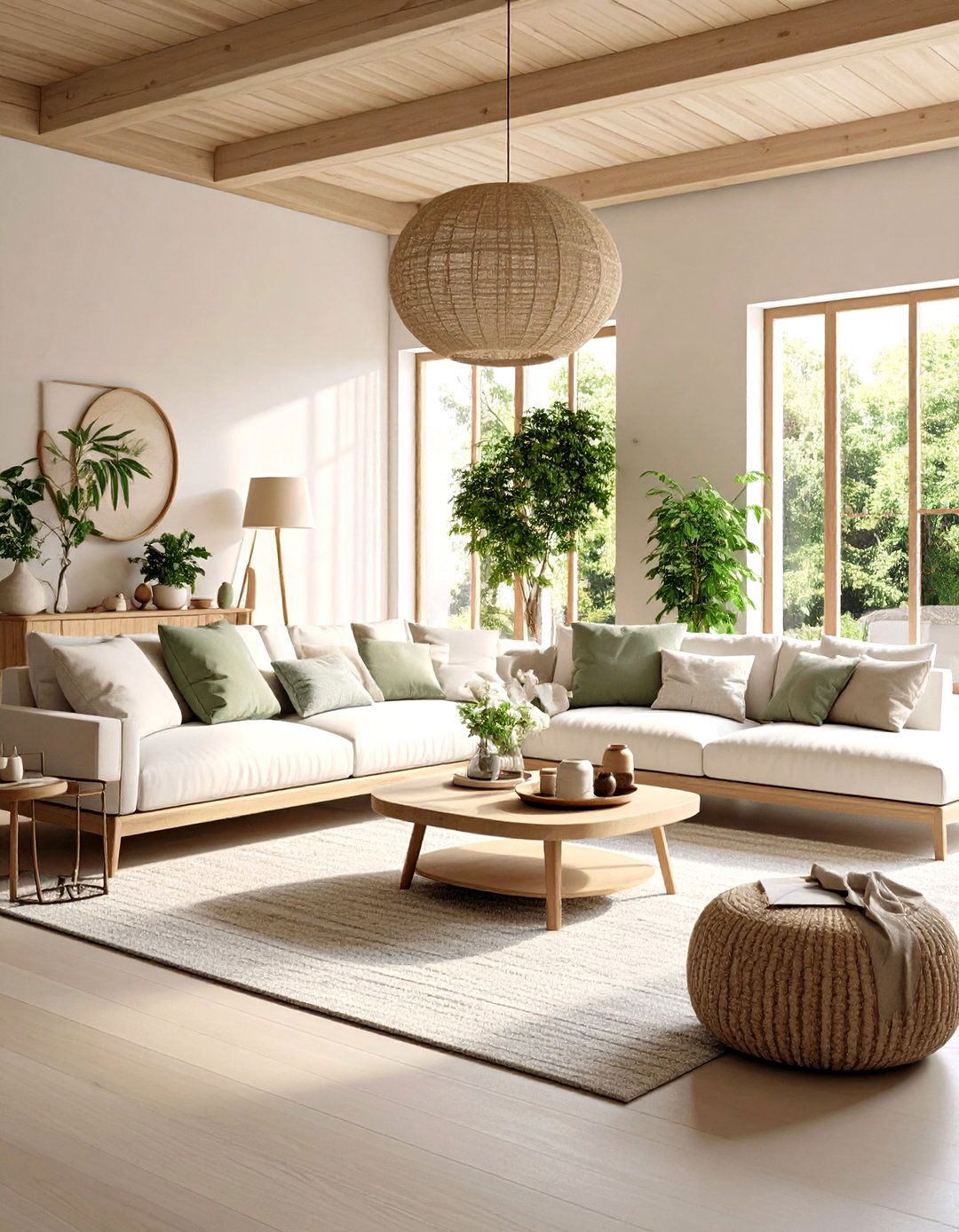
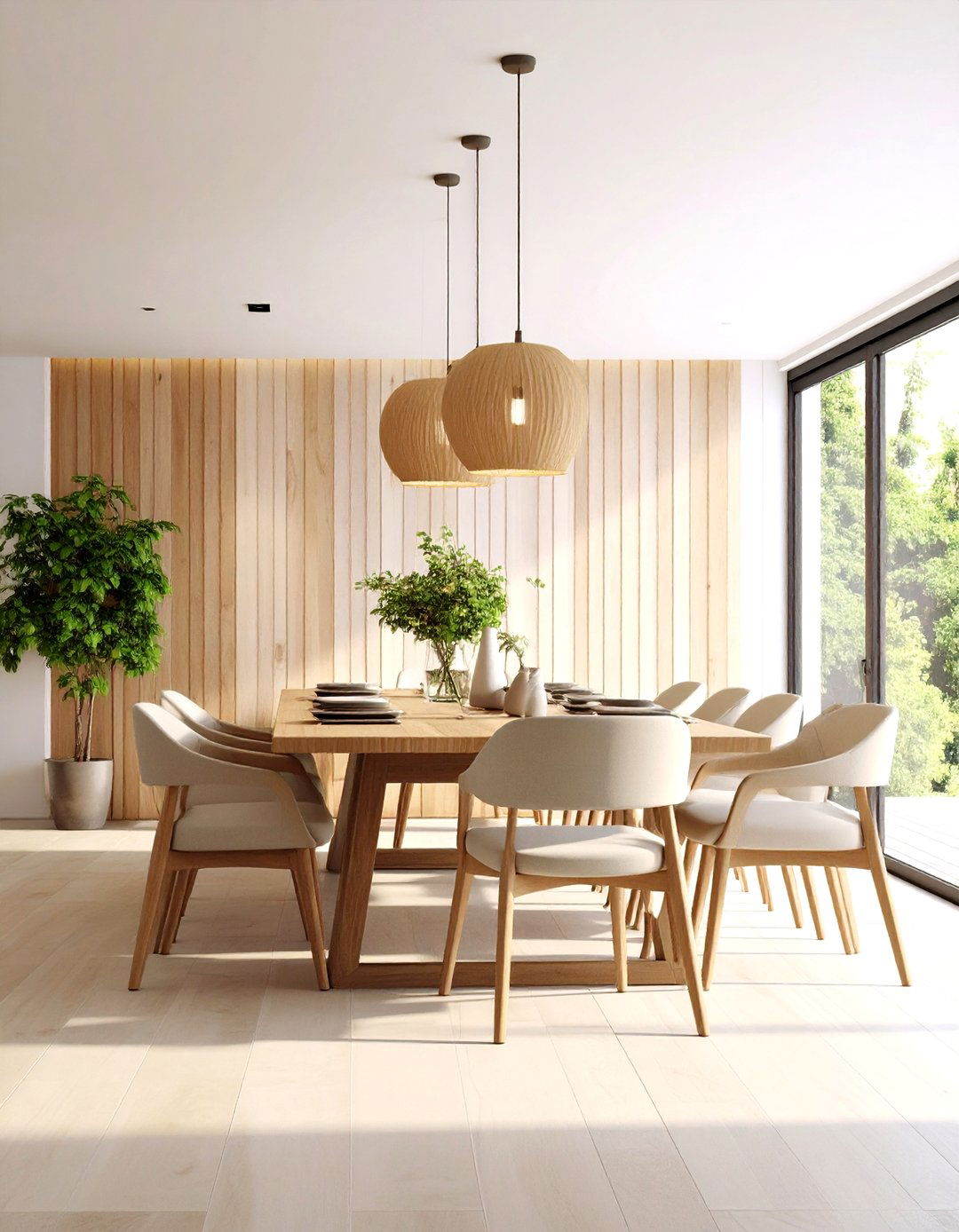
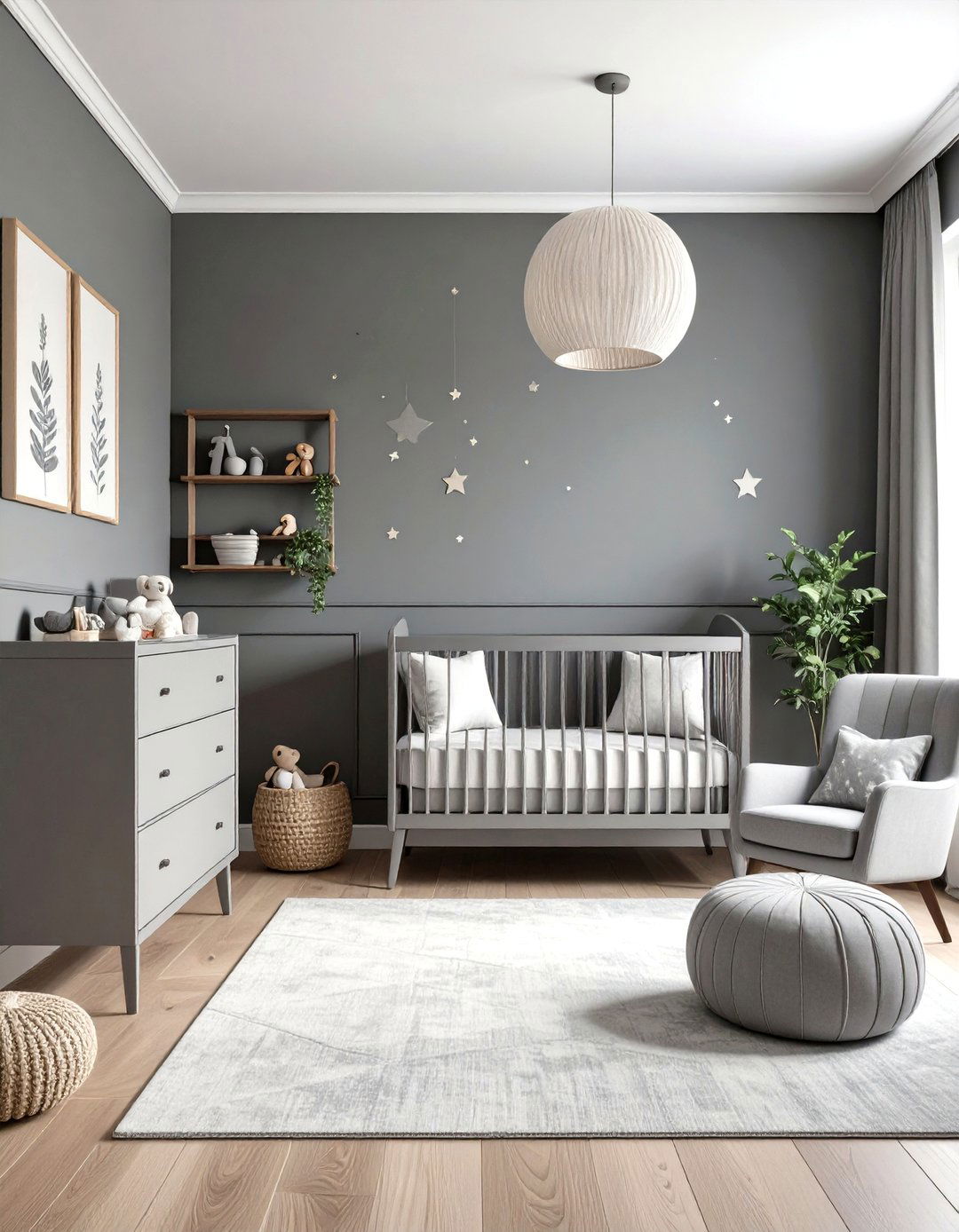
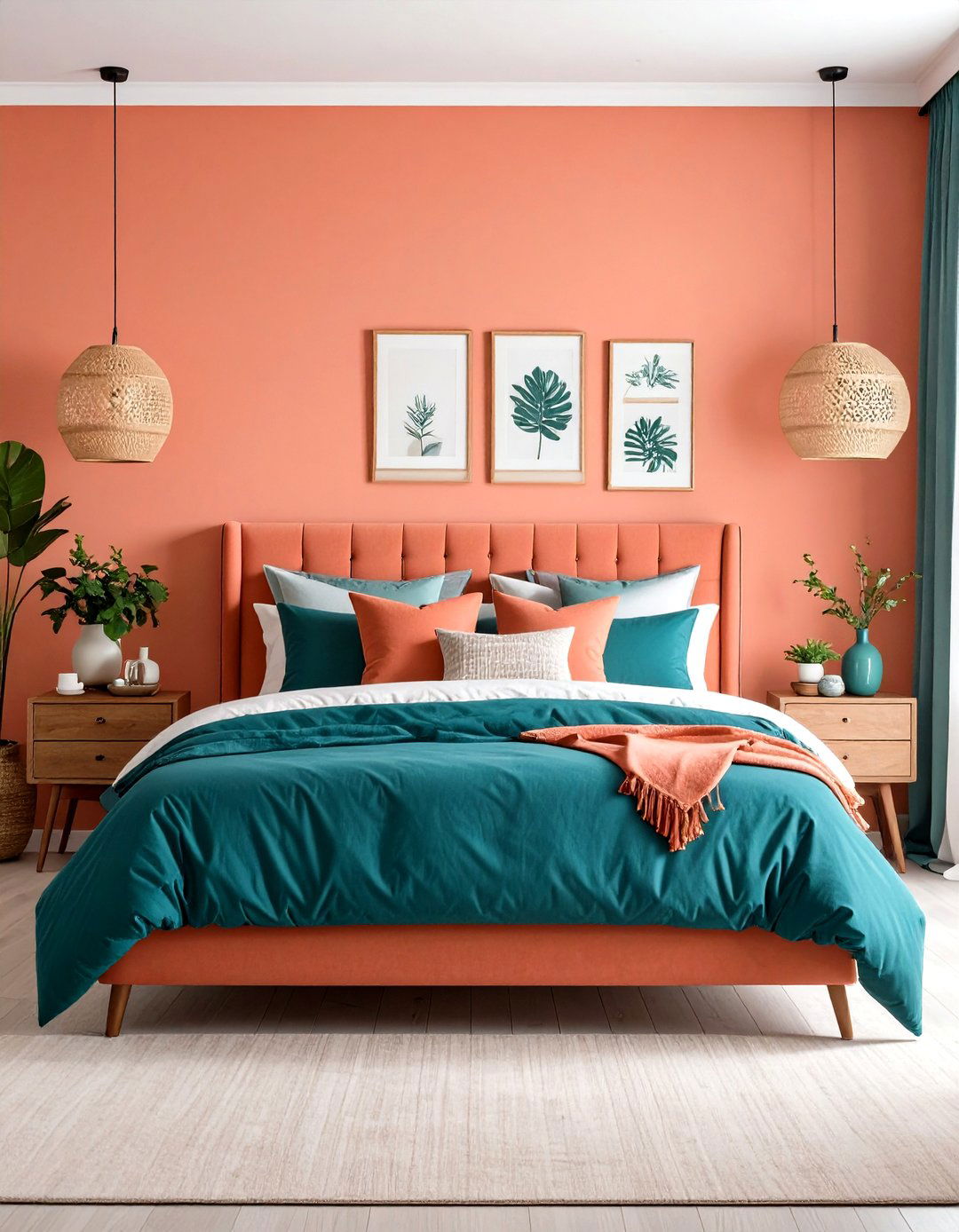
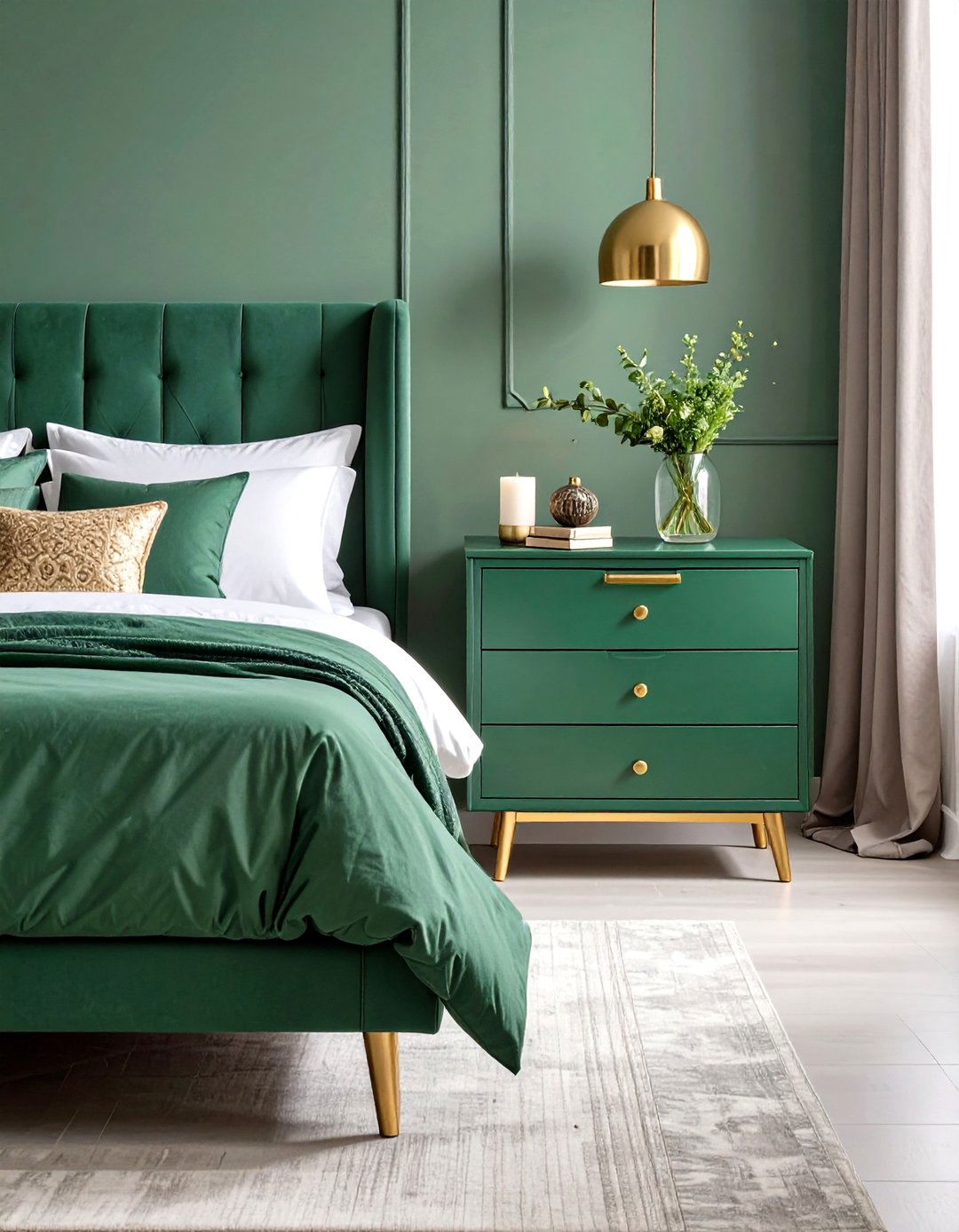
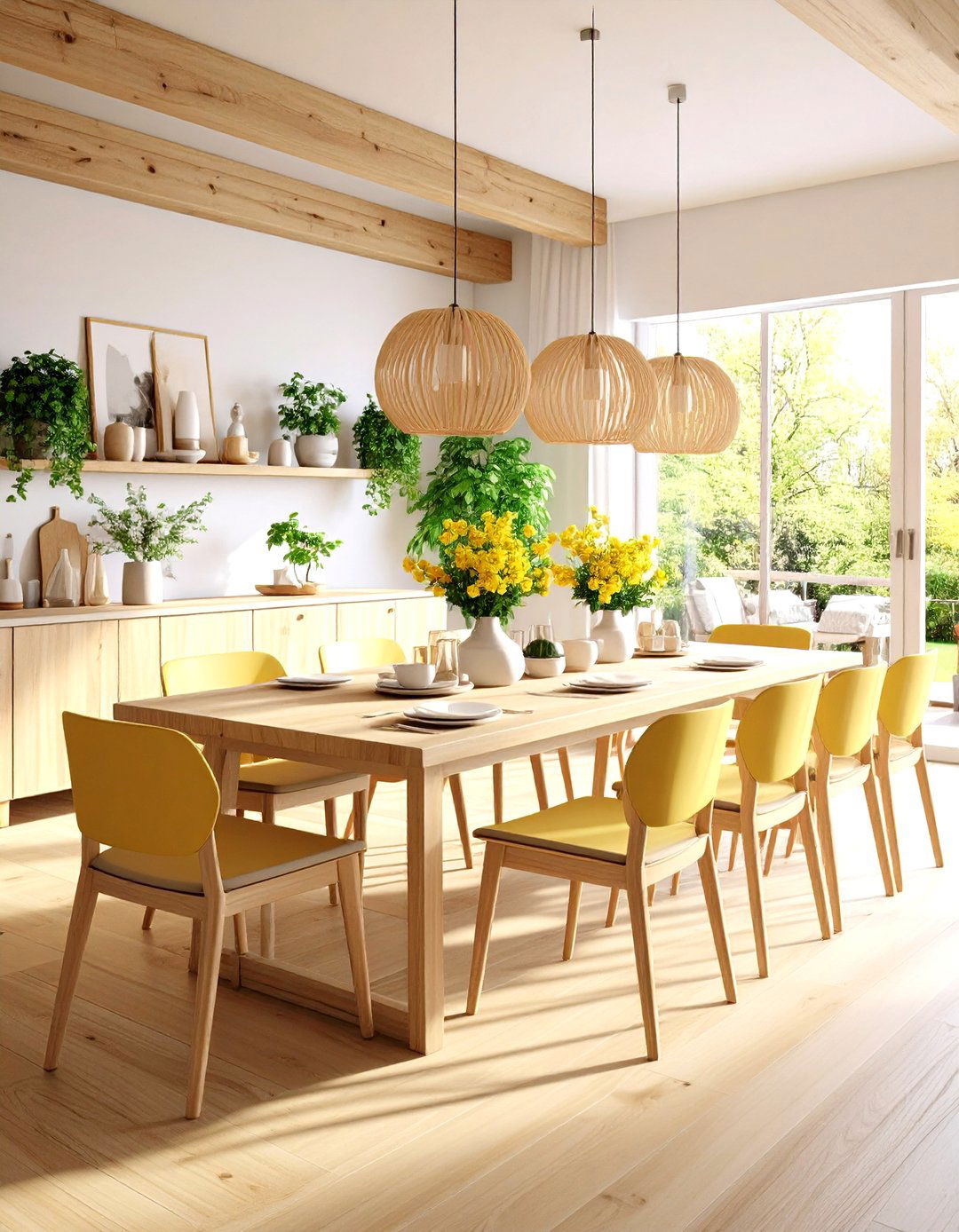

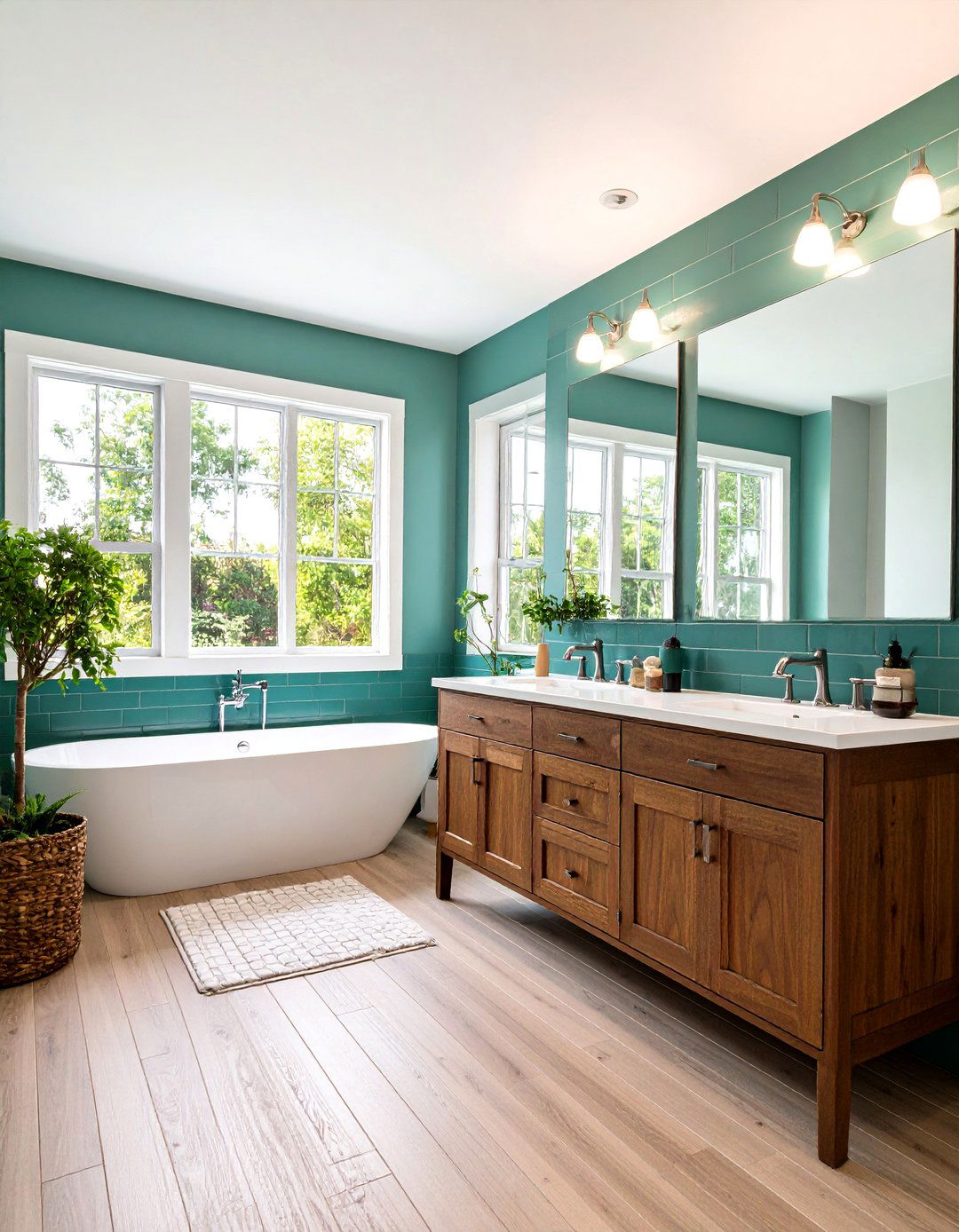
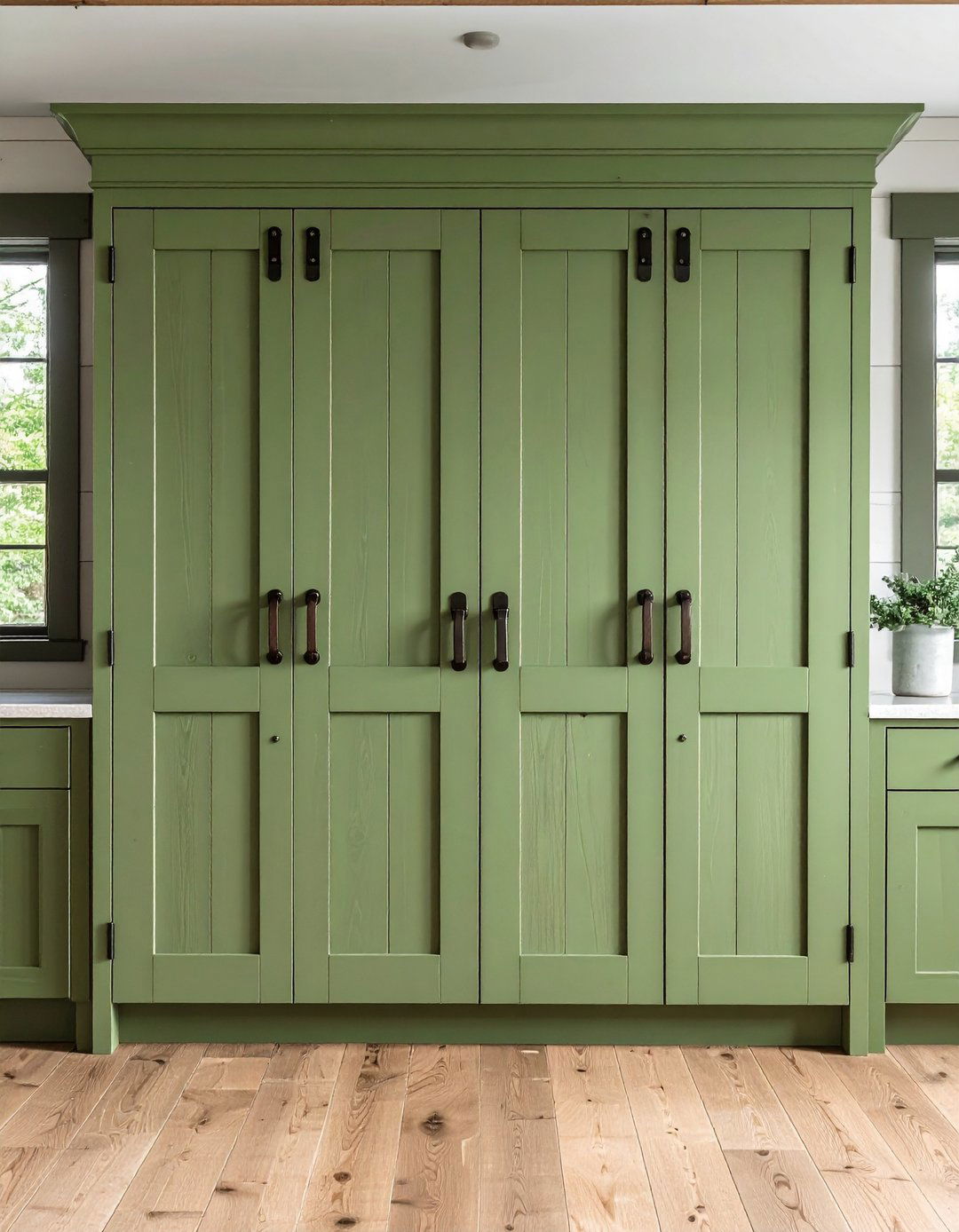
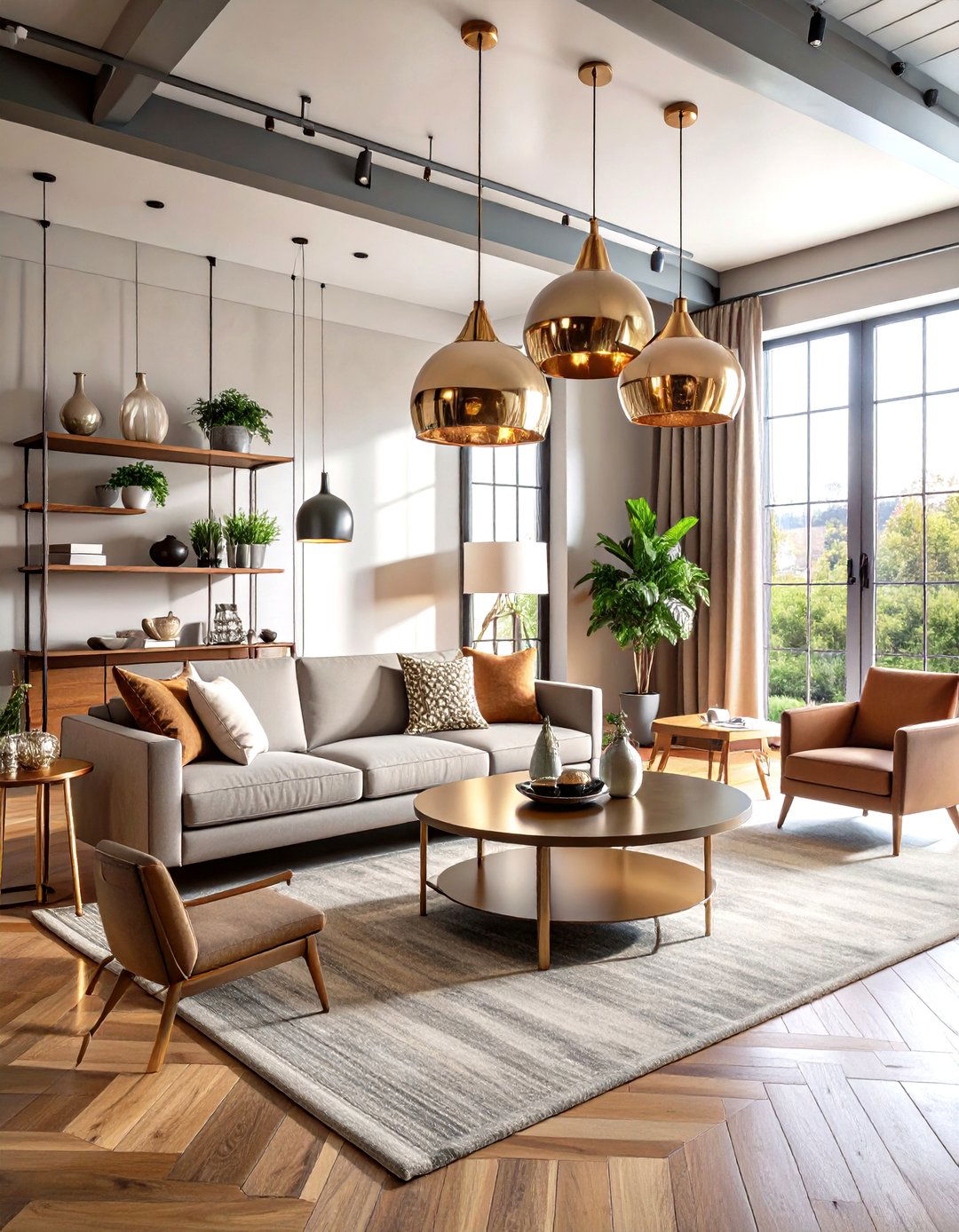
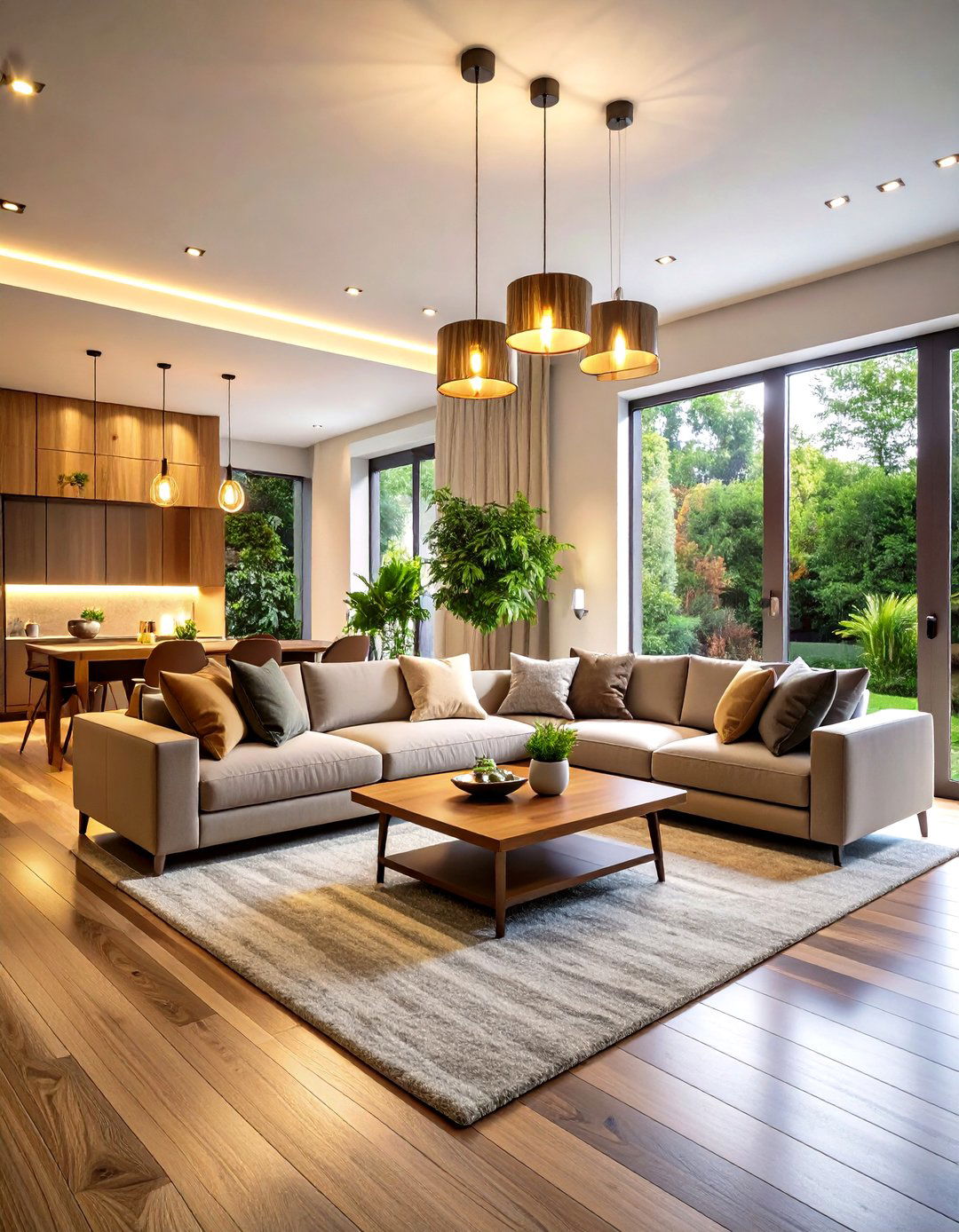
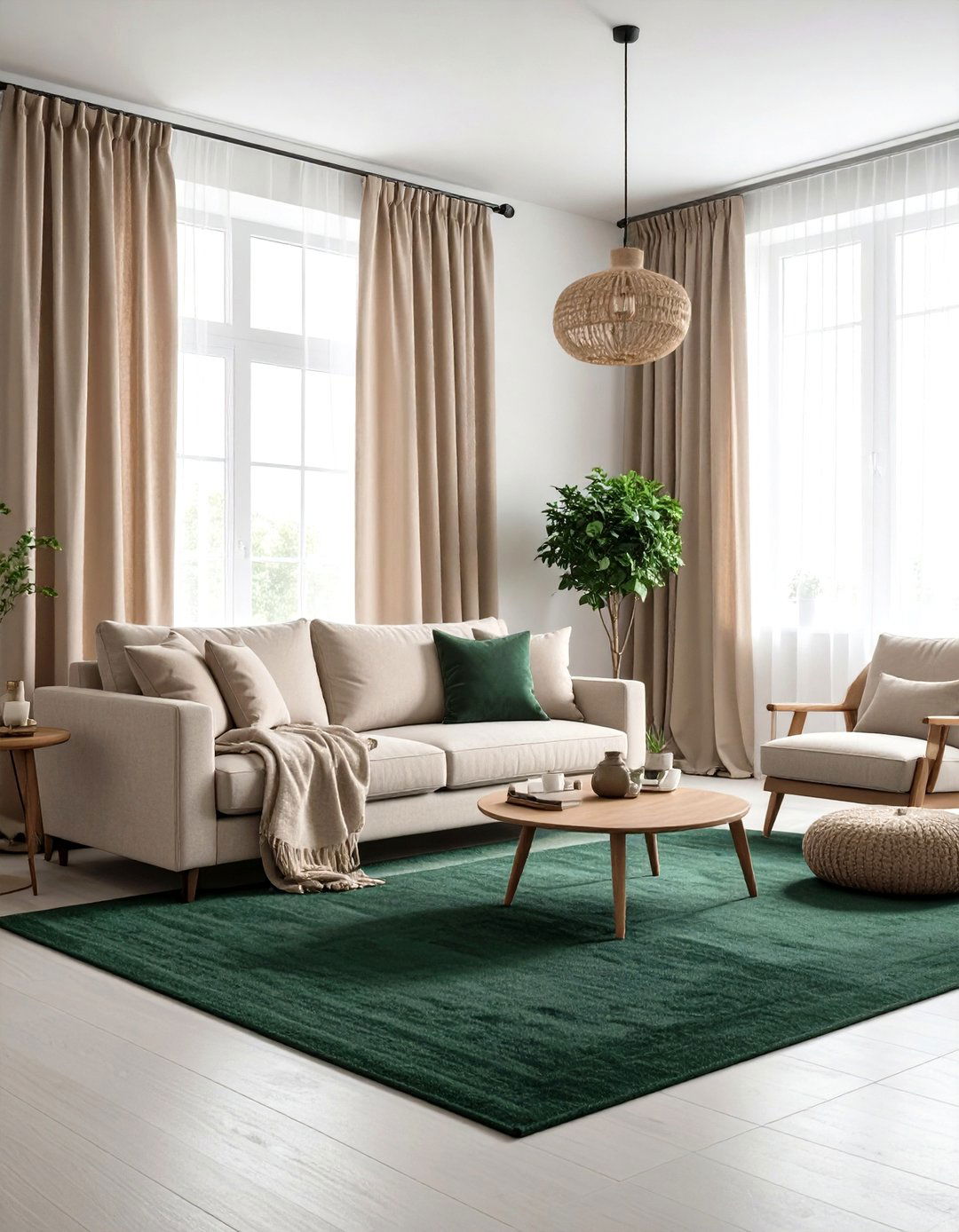
Leave a Reply